PRESENTED BY TRAVELODGE BY WYNDHAM

How to plan an epic summer trip to a national park
We’ve got insider tips on the best times to visit the most popular parks, timed entry passes, and where to stay.

As summer approaches, the siren call of national park adventures grows stronger. However, these iconic sites are bringing in unprecedented crowds.
In 2023, the National Park Service (NPS) reported over 300 million visits , a four percent increase from the previous year. This surge isn’t limited to famous spots; lesser known parks such as Congaree and Dry Tortugas are also experiencing record-breaking numbers. To manage the influx, park authorities are implementing innovative strategies to improve the guest experience.
( These are the 10 most popular national parks .)
From snagging the perfect stay to timing your bookings just right, we’ve got insider tips to ensure your national park vacation is nothing short of epic. Here’s what you need to know.
Best time to visit
Timing is crucial in planning your summer getaway, especially if you’re eyeing popular national parks. Finding affordable lodging and activities during the high season can be tricky.
During the shoulder seasons—early- to mid-spring and late fall—you can expect pleasant weather and a reprieve from the crowds, but there are a few trade-offs to consider. Some hotels and lodges might close during the off-season and reopen later in the year, potentially limiting your accommodation options. Additionally, parks at higher elevations, such as Glacier or Lassen Volcanic , may not have all their trails open and could require snowshoes or traction cleats to get around.
( Here’s why Yellowstone in the off-season is great for families .)
Arriving before sunrise has its perks, too. Typically, most visitors don’t arrive until mid-to-late morning, allowing you to enjoy attractions like Arches ’ Windows or Delicate Arch with minimal crowds, provided you arrive early enough.
When permitted, exploring the parks in winter offers a unique perspective that few experience. Yosemite Valley, for instance, transforms into a winter wonderland —a sight cherished by photographers and nature enthusiasts alike.
Tony McDaniel, a Yosemite Mariposa County spokesperson, says the best way to plan a visit is to avoid taking a “checklist approach” to your visit.
“Slow down and immerse yourself in the destination,” McDaniel says. “There’s no place on earth like Yosemite National Park , and it’s best seen slowly and outside of a vehicle where you can fully embrace the sights, sounds, and smells.”
What parks require timed entry passes?
Timed entry reservations typically provide access within a two-hour window. The price of the pass, however, does not include the standard park entry fee. But, a separate timed entry permit is unnecessary if you already have campground reservations, a wilderness permit, or bookings for a pre-arranged, park-sponsored activity. Additionally, if you plan to stay inside the park for multiple days, only one timed entry reservation is required—just make sure not to leave the park during your visit.
Although these passes can reduce a trip’s spontaneity, NPS spokeswoman Kathy Kupper says they also lead to better park experiences.
“Visitors love the timed entry system,” Kupper says, “because it gives them increased confidence that they’ll be able to get in and get where they want to go.”
If you miss out on a timed entry reservation, don’t fret. Ditch your car and opt to walk or bike into the park at any time of day. Glacier National Park adjusts its timed entry program annually, including relocating entry gates beyond the visitor center, where guests can hop on a shuttle bus to access the park.
( Ready to plan your fall hike? Read this safety advice first .)
Arches: Timed entry reservations will be required from April 1 to October 31. The reservation system operates on a rolling basis. For example, June 1–30 bookings opened March 1; July 1–31 reservations opened April 1. A limited number of reservations will also be released at 7 p.m. MST the day before, providing some flexibility for last-minute planners to Utah.

Glacier: For travelers intending to drive along the iconic Going-to-the-Sun Road or head to North Fork, Montana, a vehicle reservation is mandatory between 6 a.m. and 3 p.m. from May 24 to September 8. Similarly, from July 1 to September 8, a reservation is required to access Many Glacier between 6 a.m. and 3 p.m. These reservations can be secured up to 120 days or approximately four months in advance, starting at 8 a.m. MST. Additionally, a limited number of next-day vehicle reservations will be released at 7 p.m. MST for those seeking entry on the following day on a rolling basis.
Mount Rainier : Two areas of this Washington State park—Paradise Corridor from the south and Sunrise Corridor from the northeast—will require reservations from 7 a.m. to 3 p.m., May 24-September 2, and July 4-September 2, respectively. Each corridor requires a separate vehicle reservation, valid for a single day per vehicle. Note that reservations are unnecessary when entering the park from a different entrance.
Rocky Mountain : Between May 24 and October 20, reservations are required for entry into this Colorado park. Two types of reservations will be available: one granting access to the entire park, including the bustling Bear Lake Road Corridor from 5 a.m. to 6 p.m., and another from 9 a.m. to 2 p.m. that excludes access to this corridor. Reservations for May 24 to June 30 can be secured starting at 8 a.m. on May 1. Subsequent reservation releases will follow, with reservations for July becoming available on June 1, and so forth.
Yosemite: Reservations are needed from April to October. On Saturdays, Sundays, and holidays (May 27, June 19, September 2, and October 14) from April 13 to June 30 and August 17 to October 27, reservations are required from 5 a.m. to 4 p.m. From July 1 to August 16, reservations are needed daily during the same hours.
( Discover the best day hikes in Yosemite National Park .)
What parks require a specific area pass?

Acadia : In Maine, Cadillac Mountain Summit Road vehicle reservations are required from May 22 to October 27. About one-third of them can be purchased 90 days in advance, while the rest become available two days before, starting at 10 a.m. Reservations cost $6 and are sold only at https://www.recreation.gov/timed-entry/400000 .
Great Smoky Mountains : While you don’t need a timed entry reservation to enter this Tennessee-North Carolina park, you will need a parking permit to stop for more than 15 minutes. Passes are $5 (daily), $15 (weekly), and $40 (annually). Permits can be purchased in person or online . Passes are good for one vehicle only.
( See fireflies magically light up this national park .)
Haleakalā : To park at Hawaii’s Haleakalā summit for sunrise, you’ll need a parking pass from 3 to 7 a.m. throughout the year.
Shenandoah : Visitors hiking Virginia’s Old Rag Mountain must obtain a $2 day-use ticket in advance from March 1 to November 30. Of the 800 tickets issued daily, 400 will be released 30 days in advance, with the remaining 400 released five days beforehand on https://www.recreation.gov/ticket/10088450/ticket/10088451 .
Zion: You’ll need a timed permit to hike Angel’s Landing in Utah. Lotteries open for June-August hikes on April 1, September-November on July 1, and December-February on October 1. A limited number of next-day licenses will be available at 12:01 a.m. the day before. Hiking groups of up to six people can apply for a permit. Winning groups will be charged an additional $3 per person.
( Not a hiker? That’s not a problem at these eight national parks .)
Best alternatives to national parks
If you’re visiting in the summer, don’t have a reservation, and couldn’t get into the park early enough, you still have options. State parks and national forests surrounding official national parks often offer similar views but with few visitors.
( Go wild—and skip the crowds—at these 7 spectacular parks .)
For example, if you get shut out of Utah’s Bryce Canyon , you can always drive 15 minutes away to the picturesque Dixie National Forest . Instead of being shoulder-to-shoulder with thousands of other visitors on the trails, you’ll be almost entirely alone while overlooking nearly identical scenes.
Where to stay in or near a popular park
Most NPS campgrounds can be reserved six months in advance on a rolling basis through Recreation.gov, but the most popular sites, including Yellowstone ’s Slough Creek or Watchman in Zion , can sell out within minutes. Even if you miss out, you still have plenty of options.
“For something similar to camping in Yosemite Valley, Housekeeping Camp or Curry Village are as close as you’ll get to camping, plus you don’t need to bring a tent,” says McDaniel. “In areas like Wawona, Yosemite West, and Foresta, there are cabin rentals that will still get you into the park. Outside the park, there are hundreds of more options in great locations and historic towns that are generally more budget-friendly and put visitors close to more dining options.”
( These historic lodges are the perfect way to see North America’s wild parks .)
Nearby national forests and Bureau of Land Management areas typically offer established campgrounds or free dispersed camping (areas outside a designated campground). Sites are generally first-come, first-served. Arrive at an established campground between 10 a.m. and noon to score a recently vacated site.
Apps like AllStays and sites like freecampsites.net and Campendium can help tremendously. Signal Mountain Campground in Wyoming’s Grand Teton National Park sells out almost immediately, but on a recent trip to the park, I found an incredible mountaintop dispersed campsite, in Bridger-Teton National Forest . The view of the Tetons was spectacular, made even better because the campsite was free.
Related Topics
- NATIONAL PARKS
- ADVENTURE TRAVEL
You May Also Like

These are the 10 most popular national parks

Ready to plan your fall hike? Read this safety advice first.
Free bonus issue.

Not a hiker? That’s not a problem at these 8 national parks.

How to plan a family summer trip to the Swiss Alps

How to visit Grand Teton National Park

10 national parks to avoid the summer crowds
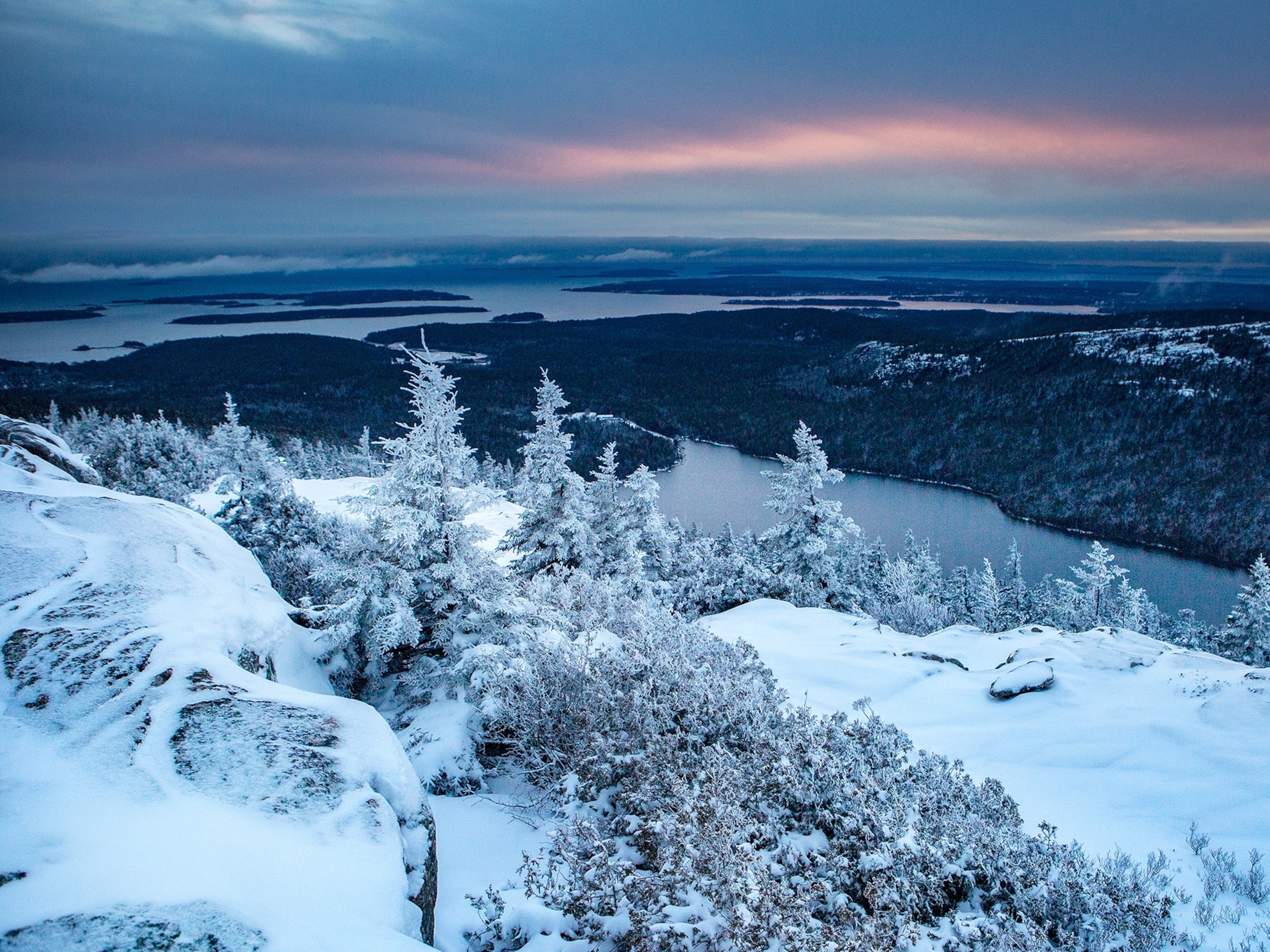
How do you avoid the crowds in national parks? Visit during winter.
- Environment
- Perpetual Planet
History & Culture
- History & Culture
- History Magazine
- Mind, Body, Wonder
- Paid Content
- Terms of Use
- Privacy Policy
- Your US State Privacy Rights
- Children's Online Privacy Policy
- Interest-Based Ads
- About Nielsen Measurement
- Do Not Sell or Share My Personal Information
- Nat Geo Home
- Attend a Live Event
- Book a Trip
- Inspire Your Kids
- Shop Nat Geo
- Visit the D.C. Museum
- Learn About Our Impact
- Support Our Mission
- Advertise With Us
- Customer Service
- Renew Subscription
- Manage Your Subscription
- Work at Nat Geo
- Sign Up for Our Newsletters
- Contribute to Protect the Planet
Copyright © 1996-2015 National Geographic Society Copyright © 2015-2024 National Geographic Partners, LLC. All rights reserved

VISIT MONCUS PARK
Know before you go, hours of operation.
Moncus Park is open seven days a week.
The Park is open from 5:00 a.m. to 10:00 p.m.
The Play Area is open from 9:00 a.m. to 9:00 p.m. The Our Lady of Lourdes Interactive Water Adventure is open from 9:00 a.m. to 9:00 p.m. for spring and summer hours. The Water Adventure is closed every Tuesday until 12:00 p.m. for cleaning.
All unimproved & unlit areas are open from sunrise to sunset.
For Park alerts and closures visit www.moncuspark.org/alerts .
Amenities and Features
• Veterans Memorial • Ochsner Playground • Our Lady of Lourdes Interactive Water Adventure • Savoy Family Treehouse • Giles Automotive Family Small Dog Park • Lake Reaux • Ochsner Pathway to Health • Orlando Mountain (highest point in Lafayette) • Walking Trails, including 1 mile loop • Fishing Pier • First Horizon Amphitheater • LPTFA Outdoor Classroom • Wetland Boardwalks • Restrooms
Rules and Guidelines
We post all rules, regulations and miscellaneous information you may need to know before visiting.
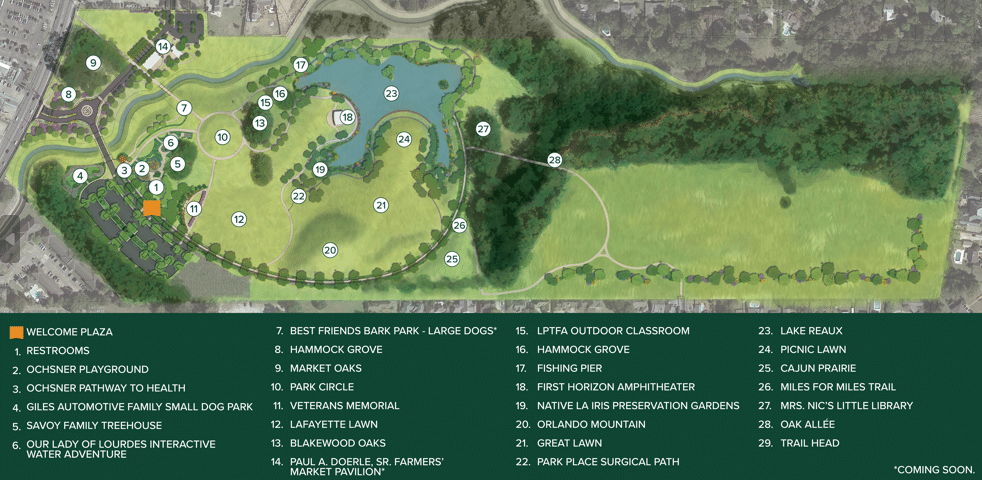
Moncus Park Parking Information
Parking Rates and Details:
Rate per Hour: $2.00 Visits Under 30 Minutes: Free Maximum Rate per Day: $10.00 Lost Ticket per Day: $10.00 Mondays: Free for all visitors
Sales tax is included in all parking rates. Credit cards ONLY at this time.
Handicap parking and ADA-accessible pathways are available.
Avoid parking in lots belonging to nearby businesses to avoid the risk of towing.
Friends of Moncus Park, our membership program participants, enjoy exclusive parking perks. Discover more at www.moncuspark.org/membership . Volunteers, programming partners, and those visiting at Moncus Park’s request will receive validated complimentary parking during scheduled appointments.
Supporting Moncus Park: Your paid parking directly contributes to the upkeep of the Park’s facilities, amenities, and the numerous free offerings, daily programs, and community events we proudly provide.
Parking Rates by Duration: Mondays: Free 0-30 minutes: Free 31-60 minutes: $2 61-120 minutes: $4 121-180 minutes: $6 181-240 minutes: $8 241-300 minutes: $10
Moncus Park offers FREE SHUTTLE RIDES from Blackham Coliseum to on Saturdays from 8:00 a.m. to 1:00 p.m. Park visitors wishing to use this convenient shuttle option can park at Blackham Coliseum’s Cabbage Patch Lot and take a free, fast shuttle to Moncus Park.
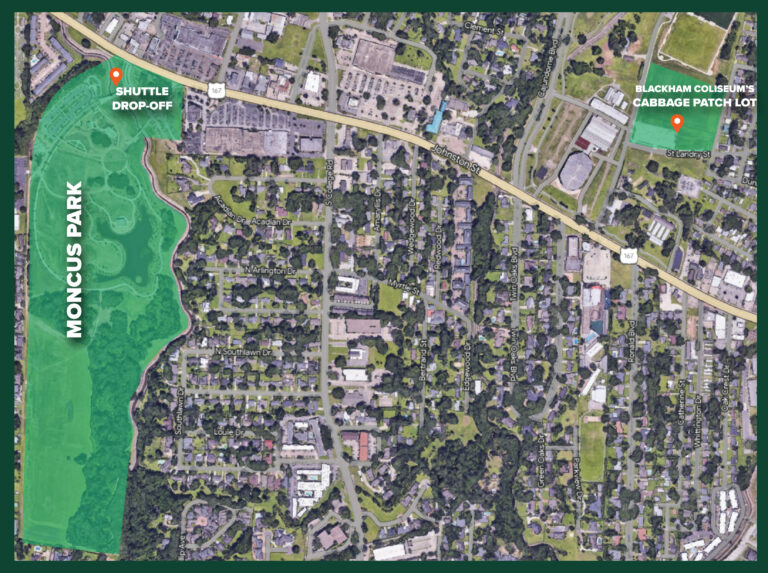
Thanks to the Louisiana Department of Wildlife and Fisheries, our 4-acre wetland pond is fully stocked! Fishing is encouraged, and we have a catch-and-release policy. If you’re 18 or older, you must have a Basic Fishing License to fish recreationally in Louisiana waters.
Bus / RV Parking
We can accommodate Bus and RV parking in our overflow lot beyond the parking lot. To let us know when you plan to visit, call our office at (337) 500-1177 Monday to Friday from 8:00 AM – 5:00 PM. There is no paid parking requirement for School Bus or RV Parking.
Field Trips
Welcome educators and students to Moncus Park, your open-air classroom where the sky's the limit for exploration and discovery. Book your field trip with us and enjoy a day of self-guided learning and play in the great outdoors. If you have questions or would like more information about booking your field trip please email us at [email protected].
Send Us Your Feedback!
We are working hard to provide an excellent experience for you. The team would LOVE your input so that we can continue to provide a quality experience when you visit Moncus Park.
Where is Moncus Park?
We are located in the heart of Lafayette at 2913 Johnston Street, Lafayette, LA 70503.
Upcoming Events & Activities

Kids Fitness with KidStrong

Dog Training By Jesse
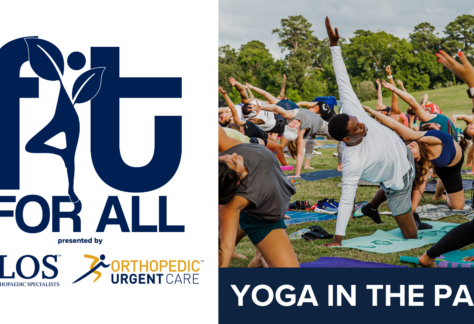
Yoga in the Park

Community Wide Drum Circle

Food Truck Friday: Family Night Out
Moncus Park 2913 Johnston Street, Lafayette, LA 70503

Lafayette Farmers & Artisans Market

Trivia Night

Turn Up Dance Fitness
© Moncus Park. Moncus Park is a 501(c)(3) nonprofit organization. All Rights Reserved. Lafayette Central Park, Inc. 2901 Johnston Street Ste 304 | 337-500-1177

Search form
Visit the park.

Find your escape in the heart of the city with wide-open fields, skyline views, rolling meadows and shady tree groves.
Dix Park is open seven days-a-week from dawn until dusk.
Getting to Dix Park
There are multiple entrances into the park. Use this address: 1030 Richardson Drive, Raleigh, NC 27603
Programs + Events
Check out our Event Calendar and join us for a variety of free classes, cultural events, programs and festivals all year long!
Plan Your Visit
Find points of interest on our Visitor Map . Click on the image to view larger and download.

The Big Field
Enjoy this expansive 35 acres of open meadow, which has a mixture of flat spaces and rolling hills bordered by a pine grove and rows of mature oak trees.
This space is popular for family and friend picnics, flying drones, playing pick-up games, running, walking dogs and flying kites. The Big Field is often the site of large festivals and community events.
Amenities: Public Parking, Swings, Benches, Hammocks, Temporary Restrooms.

Dogs can run and play off-leash in large grass-covered dog park, which is open seven days-a-week from dawn until dusk. Directions, parking, rules and more info at the link below.
Dogs must be on-leash in all areas of Dix Park outside the dog park fence.
Amenities: Water station with bottle filler and dog fountain, seating, shade structures, separate small dog area.
Dog Park opens Tuesday, February 13 th
DOG PARK INFORMATION

The Greg Poole, Jr. All Faiths Chapel serves as the park's welcome and event center. Directions, visitor hours and more information at the link below.
Amenities: Indoor accessible restrooms, water fountain and bottle station, mother's room, public parking, event rentals.
CHAPEL INFORMATION
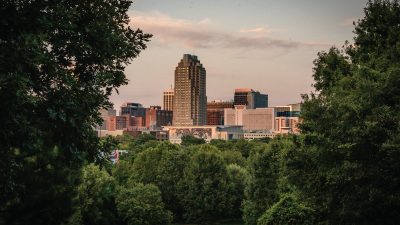
Relax on a shaded hillside with an iconic view of the Raleigh skyline or spread out and play in a flat grassy area along the Rocky Branch Greenway. In the winter, the 16-acre Grove offers the best sledding in town!
With mature oaks and views of downtown, this area is perfect for family and friend picnics and hopping on the Rocky Branch Greenway.
Amenities: Public Parking, Greenway Trailhead
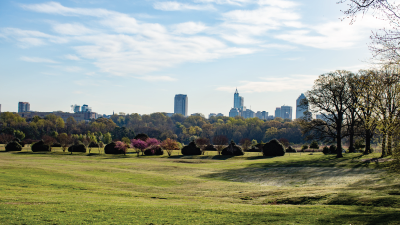
Flowers Field
Take in the grand skyline view of downtown Raleigh while enjoying 11-acres of open rolling lawn. In the early spring, a ribbon of daffodils blooms through the middle of the field.
Popular spot for family and friend meetups, picnics, pick-up games and walking dogs. Large festivals and community events often take place in this area.
Amenities: Picnic Tables, Temporary Restrooms and Hand Wash Station.
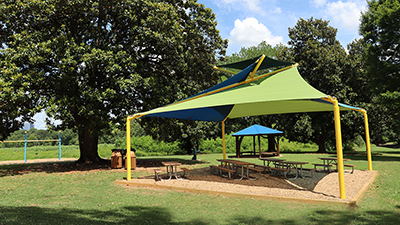
Picnic Rooms
The Magnolia Room and Oak Room are our picnic and play areas with shade structures over picnic tables. See Visitor Map for locations. Visitors can enjoy first come, first served, but event rentals have priority for use.
Amenities: 6 picnic tables with seating for 36 people, a grill, play area with swings, sway and stationary benches, water fountain, event rentals
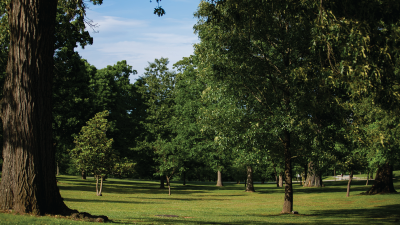
Harvey Hill
Located along the front drive of the original hospital building, mature oak trees create a shaded oasis on this 4-acre grassy hillside complete with perfectly framed views of the Raleigh Skyline.
Gather in the shade with family and friends for picnics and community gatherings.
Amenities: Public Parking
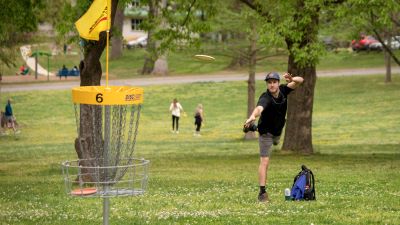
Pop-Up Disc Golf
Dix Park periodically installs a temporary 9-hole Disc Golf Course designed for players of all experience levels.
DISC GOLF INFORMATION
Host an Event at Dix Park
Located near downtown Raleigh and featuring 308 acres of rolling meadows, shady tree groves, views of the skyline, and a renovated mid-century modern chapel – Dix Park is the perfect location to host your next event.
Event Rental Information
Visit The Park
Visit the park.
Prospect Park is a world unto itself: a 585-acre oasis of scenic beauty for relaxation and recreation for our diverse community to enjoy. Browse the menu to inspire and inform your visit. In Things to Do , find information about birdwatching , nature programs , skating and much more. In Places to Go , learn about the LeFrak Center at Lakeside , the Prospect Park Tennis Center , Prospect Park’s seven playgrounds and many other beloved destinations.
The Park’s main destination for live outdoor entertainment, and home to Celebrate Brooklyn! performing arts festival.
Jutting out into the Park's 60-acre Lake, the Peninsula is an inviting place to enjoy the Park’s beautiful terrain and vistas.
This formal entrance is a memorial to the defenders of the Union in the Civil War.
This play area was created by the Alliance from trees damaged by storms and other materials to engage children with nature.
- Things to Do
There is something for everyone to enjoy in Prospect Park.
Places to Go
Explore the park’s most popular destinations.
Take a Park Tour
Join Prospect Park Alliance and Turnstile Tours on a walking tour of the park to learn more about the park and its history.
Upcoming Events
Check out all upcoming events in Brooklyn’s Prospect Park.
- Privacy Policy
Get Involved
- Volunteer in Prospect Park
- Give a Commemorative Gift
- Give Monthly
- News + Events
- Birthday Parties
Prospect Park Alliance 95 Prospect Park West Brooklyn, NY 11215 (718) 965-8951 [email protected]
Connect with Us
Love prospect park sign up for the prospect park alliance enews to be the first to learn about news and online events from brooklyn's backyard, subscribe to our mailing list, show your love for prospect park, sustain the park that sustains you, prospect park is a haven for our community, and home to brooklyn's last remaining forest and brooklyn's only lake. this spring, give back to brooklyn nature and support this beloved green space that our community of people, plants and wildlife depend on., give today to support your park..

- Share full article
Advertisement
Supported by
What to Know Before Booking a National Park Trip This Summer
Additional routes in popular parks now require reservations, the annual pass gets a big change, Juneteenth is now a new free entrance day and more changes for 2024.

By Lauren Matison
In 2023, the seashores, lakeshores, battlefields, historic sites, monuments and more that make up the National Park Service had 325.5 million visits , an increase of 4 percent from the year before.
The National Park Service director, Charles F. Sams III, praised the surge of interest in “learning our shared American story throughout the hidden gems of the National Parks System.”
Expecting an even greater turnout in 2024, the Park Service and Recreation.gov , the booking platform for federal land reservations, have implemented new measures to streamline the park experience, manage overcrowding and safeguard the environment.
More parks are requiring reservations
To better avoid congested trails, packed parking lots and overflowing trash cans, additional parks are joining Rocky Mountain , Arches and Glacier National Parks this year in requiring day-use permits, timed entries and other reservations for travelers who wish to visit, particularly during peak hours, holidays and the parks’ high seasons. Yosemite National Park is reinstating a timed-entry system it instituted in 2020, but paused in 2022.
Many park enthusiasts expressed mixed feelings about the reservation policies, with some lamenting a lack of first-come, first-served campsites while others find comfort in knowing they have a confirmed booking. As nearly 75 percent of visitors each year descend on national parks from May to October (and often on weekends), park officials stand by the system.
“In some parks, the level of demand is exceeding the capacity for which infrastructure was designed or is outpacing the National Park Service’s ability to sustainably support visitation,” said Kathy Kupper, a public affairs specialist for the service. “This trend is resulting in the need to explore new strategies to protect natural and cultural resources and provide opportunities for safe and meaningful visitor experiences.”
It can be confusing.
New to implementing timed-entry reservations for vehicles is Mount Rainier National Park , in Washington, for its popular Paradise and Sunrise Corridors during certain times in the summer season. Reservations cost $2, are valid for one day and must be purchased along with the park ticket, but do not apply for visitors with wilderness permits or camping or lodge reservations. Similar vehicle reservations are now required for certain periods for viewing the sunrise at Haleakalā National Park in Maui, Hawaii , and driving the Cadillac Summit Road in Maine’s Acadia National Park .
Visitors wishing to hike Old Rag Mountain in Virginia’s Shenandoah National Park must obtain a day-use ticket between March 1 and Nov. 30, and in Zion National Park, in Utah, hikers wishing to visit Angels Landing , the dramatic 1,488-foot-tall rock formation, also need to purchase a permit. Fees range from $1 to $6, in addition to the parks’ entrance fees.
As each destination is managed differently, check the park’s webpage for the type of reservation required. Although most bookings can be made through Recreation.gov, some sites, such as Muir Woods National Monument, use a different system.
New features on Recreation.gov
In 2023, Recreation.gov reported that more than 4 million camping reservations and 2 million timed-entry reservations were booked online, and 1.5 million permits were issued. Some 2.9 million new users signed up for the site. With its expanding user base, the booking platform has added 58 reservable national park locations — including 17 campgrounds — such as Central Avenue Walk-in Sites at Indiana Dunes National Lakeshore and Bluff Hike In Camping in South Carolina’s Congaree National Park.
Recreation.gov has also improved an alerts feature, piloted in July 2023, that can notify users through email or mobile push notifications when a sold-out campsite becomes available. After Recreation.gov notifies you of availability, you must book the campsite yourself online — and quickly, as you’ll be shown how many other people (possibly hundreds) have received the same alert.
While its customer support center and mobile app are still only available in English, Recreation.gov recently introduced a Spanish language translation option. The Park Service partners with Latino Conservation Week , which hosts nationwide hikes and events on environmental education and in-park stewardship, and will celebrate its 10th year in September.
A limit to the annual America the Beautiful pass
The 2024 America the Beautiful pass no longer allows two owners. The annual interagency pass, which costs $80 and covers the entrance fees for more than 2,000 federal recreation sites (of which roughly 100 do not charge for admission year-round), is now marked by a single signature line on the back of the card. The pass owner must show I.D. and be present with any accompanying travelers wishing to access the park with the pass. (Annual passes issued in 2023 will still be valid until their expiration date.) The pass covers all passengers in a vehicle — up to four adults, and children under 16 are admitted free — or up to four cyclists riding together. Active military or veterans and people with permanent disabilities are eligible for a free lifetime pass; 4th grade students may receive a free annual pass; and senior citizens may purchase a $20 annual pass or pay $80 for a lifetime pass.
At the parks, more accessible features, E.V. chargers and new lodging
To better protect against global warming, the Park Service is putting more than $65 million from the Inflation Reduction Act and Great American Outdoors Act into climate mitigation and ecosystem restoration.
Using $15.9 million budgeted for zero-emission vehicle deployment, charging capacity and infrastructure, the Park Service is prioritizing a reduction in carbon emissions, said Mr. Sams, by installing new electric-vehicle charging stations and running electric buses.
An interactive online locator tool created in 2023 shows E.V. charging stations throughout 27 national parks and the type of chargers available. In addition to the tool, every national park page displays alerts on road closures, parking lot capacities, construction work and other incidents.
Mr. Sams also said the Park Service is investing $1.3 billion from the Great American Outdoors Act to improve accessibility features, ranging from a new A.D.A.-compliant visitor center at Morristown National Historic Park in New Jersey to new beach wheelchairs at Sleeping Bear Dunes , Channel Islands and Virgin Islands National Parks . Each destination’s website has an accessibility tab to help visitors plan their trip, and Recreation.gov now has a search filter on its homepage to make it easier to locate accessible accommodations.
New lodging options now available across the country include the Flamingo Lodge , which opened inside Everglades National Park last fall with 24 guest rooms built from repurposed shipping containers. In March, along the southeastern border of Great Smoky Mountains National Park, the Cataloochee Ranch reopened with 11 renovated cabins and a new restaurant. This spring, the Clubhouse Hotel & Suites will welcome its first guests in Rapid City, S.D., the closest major town to Badlands National Park , and opening in May in Idaho is the Yellowstone Peaks Hotel , a 30-minute-drive from Yellowstone National Park. This fall, California-bound travelers planning a visit to General Sherman, the largest known tree on Earth, might book at AutoCamp Sequoia , just outside Sequoia and Kings Canyon National Park .
Also in California: Those who don’t score a highly coveted (and contentious) spot at the newly reopened High Sierra Camps in Yosemite could book Wildhaven Yosemite in Mariposa, which offers more affordable rates, hiking trails and views of the Sierra Nevadas. Reservations for its first season are available beginning May 1.
Celebrating milestones and a new free entrance day
On the 60th anniversary of the Civil Rights Act, visitors can pay tribute to African American heritage at over 100 parks , including the Frederick Douglass National Historic Site in Washington, D.C., Birmingham Civil Rights National Monument , and the Selma to Montgomery National Historic Trail . This year also marks 100 years since Indigenous people were recognized as United States citizens. Although many parks have Indigenous programming , Mr. Sams, who is the first Native American to serve as N.P.S. director , suggested visiting Hopewell Cultural Historical Park in Ohio and Whitman Mission Historic National Historic Site in Washington, where he recently brought his daughter.
“In order to celebrate the diversity that makes our country great, we must share the complete story of America, which includes both the successes and challenges encountered on the way to form a more perfect union,” Mr. Sams said.
Juneteenth National Independence Day is the National Park Service’s newest free entrance day . Visitors can also take advantage of free admission on April 20, the first day of National Park Week; Aug. 4, the four-year anniversary of the Great American Outdoors Act ; Sept. 28 on National Public Lands Day ; and Nov. 11 for Veterans Day .
Follow New York Times Travel on Instagram and sign up for our weekly Travel Dispatch newsletter to get expert tips on traveling smarter and inspiration for your next vacation. Dreaming up a future getaway or just armchair traveling? Check out our 52 Places to Go in 2024 .
An earlier version of this article misstated the location of the Flamingo Lodge. It is inside Everglades National Park, not outside the park.
How we handle corrections
You are using an outdated browser. Please upgrade your browser .
- Gorky Central Park of Culture and Recreation, Moscow
- Guide to Russia
What is the history of Gorky Park?
- In the pre-revolutionary period, Gorky Park was a city dump and wasteland, which was cleared in 1923 to host the All-Russian Agricultural and Artisan Industrial Exhibition
- In 1928, a huge park was planned on the former site of the exhibition. It would not just be a place of leisure, but a place to proudly display Soviet culture and daily life
- Gorky Park has remained a cultural hub ever since, and has been renovated and added to over the years to make it one of Moscow’s top attractions today
Gorky Central Park of Culture and Recreation
Gorky Park is the most famous park of Moscow, created during the Soviet period as a hub for relaxation and cultural activities. The park is beloved by Muscovites and tourists alike, who visit in all seasons to stroll, enjoy sports, admire the park’s attractions, and attend cultural events. Gorky Park is the central part of an ensemble of four green spaces – Muzeon Park of Arts, Neskuchny Garden, and Sparrow Hills Nature Reserve – which curve around the southern bank of the Moskva River to the south-west of Moscow city centre. Here you may spend some time and enjoy nature and contemprary art during your vacation in Moscow .
History of Gorky Park
Imperial russia.
In the 17th century, the eastern bank of the Moskva River beyond Moscow’s city limits was home to floodplain meadows, where palace horses grazed. From the mid-1850s, events such as cockfights, fistfights, and races were held here, and by the 20th century this area had become a city dump where the unemployed and homeless people of Moscow lived, which remained this way until the Soviet period. This wasteland lay in stark contrast to the adjoining Neskuchny Sad – ‘merry garden’ – which lay to its south, an area of aristocratic country estates and elaborate gardens.
Soviet Russia
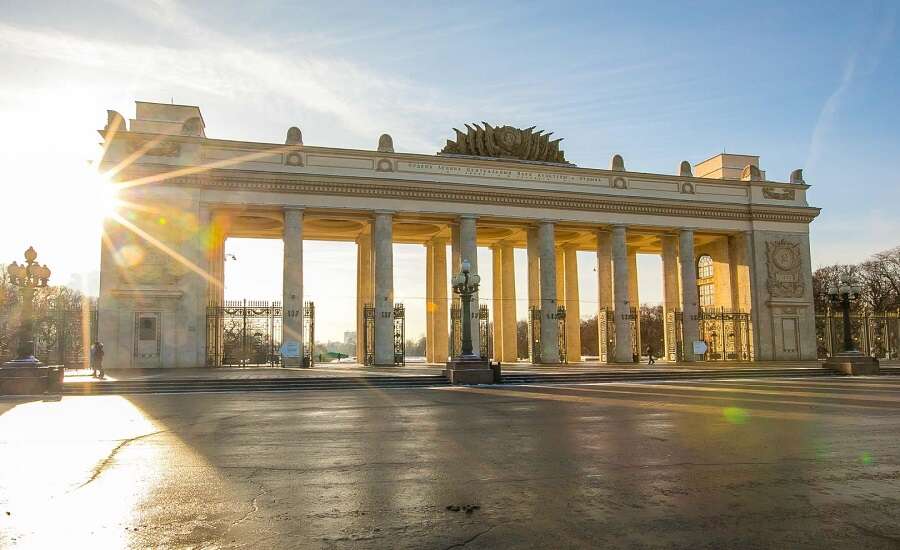
Photo from https://parkseason.ru/
Following the October Revolution, Vladimir Lenin travelled around Moscow to find a suitable site for the first All-Russian Agricultural and Artisan Industrial Exhibition, which would reveal opportunities for socialist development of agriculture and industry. Lenin decided on the wasteland alongside the Moskva River, which was cleared with a programme of community work. In 1923, the exhibition began. It encompassed 250 pavilions dedicated to different themes of agriculture and industry, and was divided into thematic zones, such as villages, livestock, crops, engineering, railways, republics of the USSR, and foreign countries. The organisation of the exhibition demarcated the future layout and size of Gorky Park, and the paths, ‘zones’, and main square of the exhibition have been preserved until the present day. In March 1928, Moscow City Council decided to establish a park of culture and recreation on the site of the former exhibition, which would also encompass the Neskuchny Garden. Moscow’s residents were instrumental in the construction of the park – they voiced their desires for events spaces, physical education and leisure facilities, and gave up their weekends to build the park. The park’s main architect was Konstantin Melnikov.
Did you know? Konstantin Melnikov also helped to construct Lenin’s Mausoleum and the Rusakov Worker’s Club, one of Moscow’s Constructivist masterpieces .
Over 100,000 Muscovites flocked to the opening of the park on 12th August 1928. The brand-new park was equipped with two theatres, a cinema, nursery, reading room, restaurant and café, music stages, sports arenas, rowing boats, and even a giant helter-skelter slide. Unfortunately, because of the vast size of the crowd and the general excitement, the park was damaged and closed until September.
Did you know? The park was not named after Maxim Gorky, writer and founder of Socialist Realism, until 1933.
In 1929, Betty Glan – at the mere age of 26 – became director of the park. She decided to reconceptualise it, uniting leisure, design, and ideology with the help of Moscow’s most eminent architects, designers and artists. Over the next decade, more cultural venues were established in the park, the Pushkinskaya Embankment along the Moskva River was developed, and the landscaping of the park was carefully cultivated. Architect Alexander Vlasov was particularly influential, and won the Grand Prix at the 1937 World Exhibition in Paris for his design of Gorky Park. This period under Glan’s directorship until 1937 was known as the ‘golden age’ of Gorky Park, which became not just a place for recreation, but a public space where Soviet culture and everyday life could be proudly displayed.
Did you know? During the Second World War topical events were held in Gorky Park, such as the championship in bayonet combat, grenade-throwing competitions, and air defence training. What’s more, an exhibition of captured enemy weapons – tanks, artillery, aeroplanes, and more – was organised in Gorky Park and continually updated throughout the war.
In the post-war decades new attractions were continually added to Gorky Park. These included the majestic 24-metre triumphal arch at the entrance to the park, an astronomical observatory (which remains open today), the famous Ferris wheel (unfortunately dismantled in 2008), and a fountain with lights and music.
Russia today
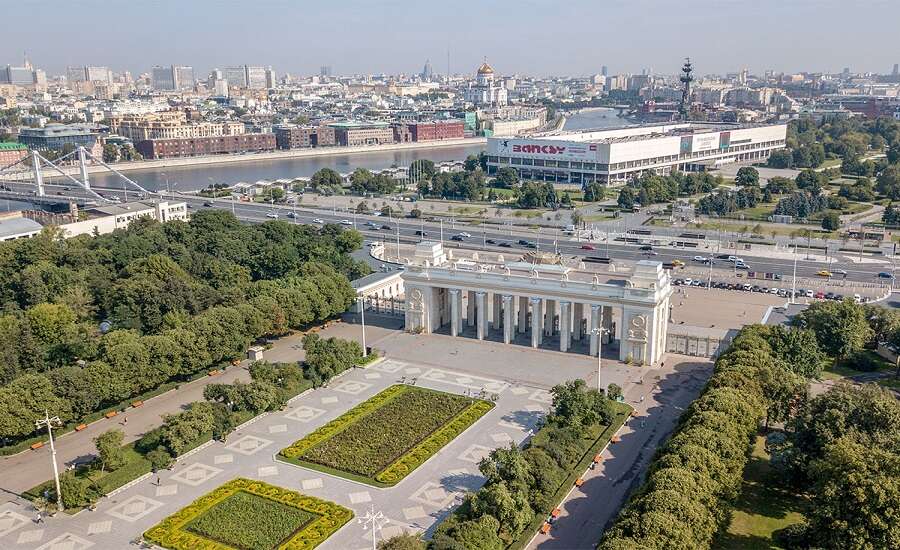
Photo from https://countryscanner.ru/
The Gorky Park ensemble continued to flourish as a centre of culture and recreation in post-Soviet Russia. The adjoining Muzeon Park of Arts was founded in 1992, and Garage Museum of Contemporary Art was established in Gorky Park in 2008. The ensemble underwent serious reconstruction in 2011. Many new sports facilities were added, including centres for beach sports and extreme sports, bicycle paths and sports equipment rental hubs, and much effort was devoted to reviving original buildings, sculptures, and landscape compositions. Two years later, the embankment of the Moskva River from the southern tip of Zamoskvorechye Island all the way to Sparrow Hills was redeveloped and pedestrianised, making it possible to peacefully walk or cycle along the Moskva for many kilometres.
What can you do at Gorky Park today?
- Explore the park and see architectural attractions, fountains, and beautiful gardens
- Visit Garage Museum of Contemporary Art and the Gorky Park Museum
- Go boating on the lakes and stroll down the Pushkinskaya Embankment
- Rent bicycles or scooters, skateboard, and visit the sports centres
What can you do at Gorky Park?
Park attractions.
While exploring the treelined paths of Gorky Park, you’ll come across a number of attractions. To the west of the main entrance, near the river, is a beautiful geometric bandstand used for music and literary evenings in the Soviet period. As you head down the central alley of Gorky Park from the main entrance, you’ll see a statue of Maxim Gorky on your right, and discover the light and music fountain with its dancing jets of water – find the schedule of its performances here .
Did you know? Don’t be afraid to feed the red squirrels and birds you encounter on your walk around Gorky Park – there are even vending machines which sell special food for the animals!
The southern section of Gorky Park is occupied by the Golitsynsky Garden. In 1802, the Golitsyn Hospital was founded here as a hospital for the poor; it still adjoins Gorky Park today. Gardens were created as a relaxation place for patients, extending from the hospital building to the riverbank, and included landscaped gardens, a Chinese Bridge, and two ponds. On the riverbank is the Rotunda of the Golitsyn Hospital, which has been preserved since the 19th century. There is also a rose garden and fountain by the Bolshoi Golitsynsky Pond.
Did you know? In the Golitsynsky Garden is also located an unusual architectural monument – a public toilet designed by Alexander Vlasov in the 1930s, which is recognised as an ‘object of cultural heritage’!
Outdoor activities
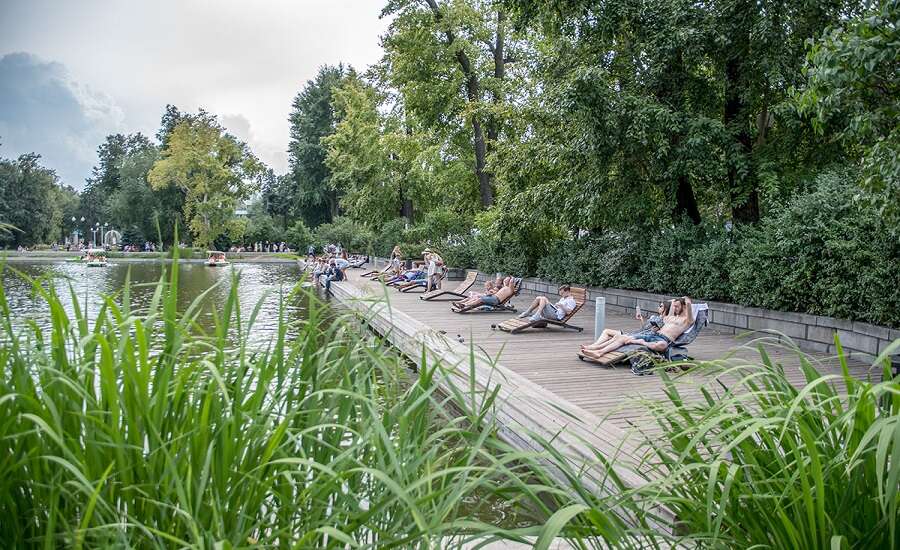
Gorky Park’s extensive and varied grounds aren’t only good for walks! You can relax on the water by renting boats to sail on the Pionersky and Bolshoi Golitsynsky Ponds, or visiting the Olivkovy Beach on the Pushkinskaya Embankment to sunbathe. As well as this, you can hire bicycles, electric scooters, longboards or even roller skates to explore the park and embankments, play table tennis, visit the sports complex to play football, basketball, handball, badminton or volleyball, or visit the Vans skatepark or Nike sports centre for workouts and classes such as rooftop yoga.
Gorky Park Museum
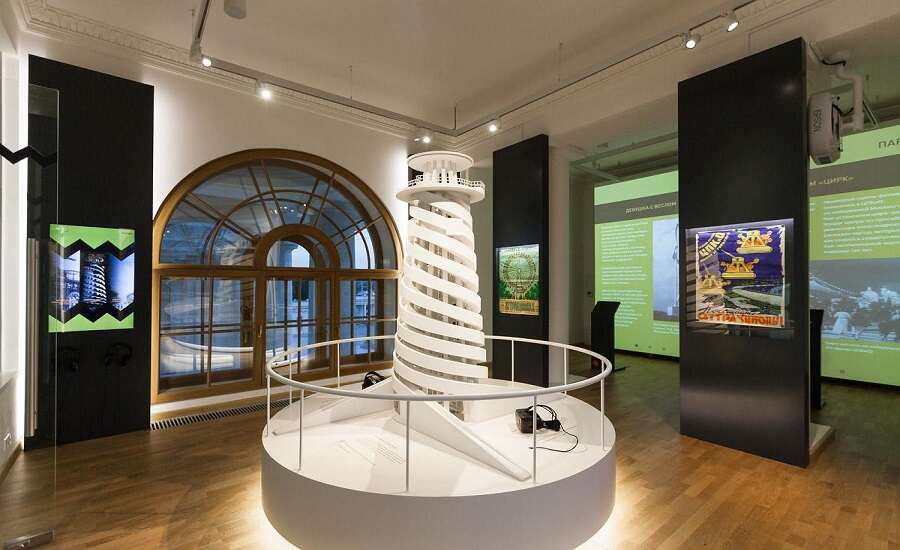
Photo from http://themedium.ru/
Visit the Gorky Park Museum, located in the left pier of the entrance arch. The current exhibition is dedicated to Gorky Park in the ‘golden age’ of the 1930s, and shows the development of Moscow’s central park through the eyes of Betty Glan. There is an observation deck on top of the arch, which offers a lovely view over the park and Moscow’s skyline.
Did you know? In the entrance arch there is also a gift shop where you can purchase balls, frisbees, blankets, and other items to enjoy your visit to Gorky Park.
Garage Museum of Contemporary Art
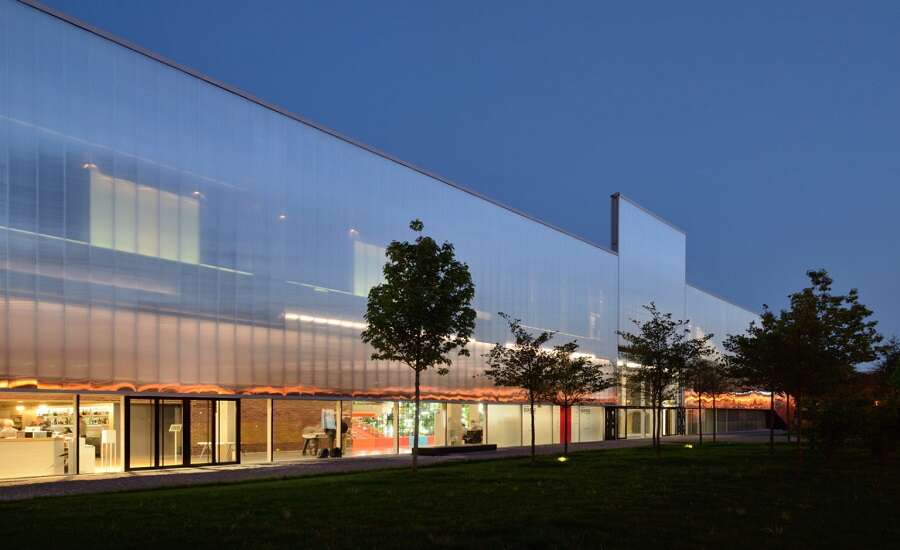
Photo from https://muzeolog.com/
In Gorky Park you will find Garage Museum, Russia’s first philanthropic institution dedicated to contemporary art, founded in 2008 by Roman Abramovich and Dasha Zhukova. 10 major exhibitions are hosted each year to showcase the work of established and up-and-coming artists. Also organised are a rich programme of events including curator-led excursions, workshops, masterclasses, lectures, concerts, performances, festivals, and film screenings at Garage’s outdoor cinema. Read our article about Garage Museum of Contemporary Art to learn more.
Food and drink
There are plenty of excellent cafes and restaurants dotted around Gorky Park, where you can stop for a quick coffee or enjoy a long meal with a view. They include the stylish lakeside café Ostrovok (Little Island) and upmarket restaurant Vremena Goda (Seasons) which serve European and Russian food, colourful lakeside Thai restaurant Lebedinoe Ozero (Swan Lake), trattoria Merkato with its huge summer terrace, restaurant Syrovarnya (Cheese Factory) with a menu focused on its homemade cheese, food-truck court Restoparking which is stylised as a drive-in café, and ice-cream and tea shop Chaynaya Vysota.
What’s nearby?
Gorky Park is bordered by Muzeon Park of Arts, Neskuchny Garden, and Sparrow Hills Nature Reserve. This huge ensemble curves for eight kilometres along the bank of the Moskva River, providing a beautiful oasis of green in Europe’s biggest city.
Muzeon Park of Arts

Photo from https://new-magazine.ru/
Muzeon Park of Arts is the largest open-air sculpture museum in Russia, home to 1,000 sculptures by Soviet and Russian sculptors, including those by famous artists. A large part of Muzeon is occupied by the New Tretyakov Gallery , which houses Russia’s most complete exhibition of national art from the 20th century to the present day. The pedestrianised Krymskaya Embankment which extends alongside Muzeon has recently undergone redevelopment, and is one of Moscow’s most popular spots to relax.
Neskuchny Garden
Neskuchny Garden is the oldest park in Moscow, founded in 1728 by Prince Nikita Trubetskoy, who threw fantastic festivities in his manor house and gardens – neskuchny means ‘merry’ in Russian. Many other noble families also built their country estates in this area, which became a public park and garden after being acquired by the royal family. Today, the Neskuchny Garden is home to historical buildings, fountains, and gardens from the 18th and 19th centuries, sports facilities, an open-air theatre, and a huge greenhouse which supplies flowers to Gorky Park.
Sparrow Hills
Sparrow Hills Nature Reserve is a huge forest park lining the steep bank of the Moskva River and the only specially protected nature area near the city centre. It is home to ecological trails, ponds, natural springs, rare species of plants and animals, many spots for picnicking, cafes, and a mini zoo. At the bottom of the park lie the Vorobyovskaya and Andreevskaya Embankments, with promenades along the Moskva River, a beach, and piers offering boat trips. As with Gorky Park, Sparrow Hills is hugely popular for sports and outdoor activities in all seasons. A new winter sports complex with snowboarding, ice skating, and ski tracks and jumps is currently under construction. When the weather is pleasant, you can rent a bicycle to ride the 8 kilometres along the river from Muzeon to Sparrow Hills.
Essential information for visitors Address and contact details Gorky Park, Krymsky Val, 9, Moscow, 119049 Website: https://park-gorkogo.com/ Email: [email protected] Telephone: +7 (495) 995-00-20 Nearest metro: Oktyabrskaya (570m), Park Kultury (860m) Opening hours and tickets
Related Tours
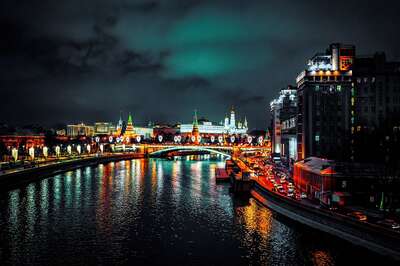
Highlights of Two Capitals
This is a well-balanced tour of Moscow and St. Petersburg that includes all must-see sights, such as the Kremlin, Red Square, the Peter and Paul Fortress, Peterhof with its world-famous fountains and, of course, the Hermitage Museum.
Accommodation
PRIVATE TOUR
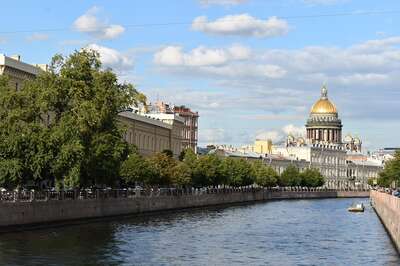
Jewels of Two Capitals
It is our most complete and popular tour of Moscow and St. Petersburg. In addition to visiting all the emblematic places, you will also have free time for your own discoveries. On your free nights you can watch the shows at the Bolshoi and Mariinsky Theaters or a folkloric show.

Classic Moscow
This is our most popular Moscow tour that includes all the most prominent sights. You will become acquainted with ancient Russia in the Kremlin, admire Russian art in the Tretyakov Gallery, listen to street musicians as you stroll along the Old Arbat street, and learn about Soviet times on the Moscow Metro tour.
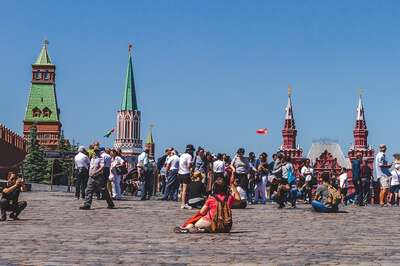
Group Tour Moscow Break by Intourist
Russia's capital has so much to offer, from the Kremlin and the Metro to the Old Arbat street and the Tretyakov Gallery. Besides these sites, you will also visit a fascinating country estate which today is quite off the beaten path, Gorky Estate, where the Soviet leader Lenin spent the last months of his life.
Our travel brands include

Express to Russia
Join us on Facebook
We invite you to become a fan of our company on Facebook and read Russian news and travel stories. To become a fan, click here .
Join our own Russian Travel, Culture and Literature Club on Facebook. The club was created to be a place for everyone with an interest in Russia to get to know each other and share experiences, stories, pictures and advice. To join our club, please follow this link .
We use cookies to improve your experience on our Website, and to facilitate providing you with services available through our Website. To opt out of non-essential cookies, please click here . By continuing to use our Website, you accept our use of cookies, the terms of our Privacy Policy and Terms of Service . I agree
- Skip to primary navigation
- Skip to main content
- Skip to primary sidebar
- Skip to footer
TravelAwaits
Our mission is to serve the 50+ traveler who's ready to cross a few items off their bucket list.
19 Unique And Fabulous Experiences In Moscow

- Destinations
Thinking of visiting Russia? When visiting such a famous city, one must, of course, visit the iconic landmarks first. Moscow has plenty of those, most of them in the center of the city, which is very well-planned for tourists. Once you’ve seen the sights that are on most travelers’ lists, it’s time to branch out and visit some of the lesser-known sites, and there are some fascinating places to see and things to do.
I know this list is long, but I just couldn’t help myself. You probably won’t have the time to see them all. But that’s okay. Just scroll through the list and choose what sounds the most interesting to you. Where possible, make sure to book in advance, as things can get crowded, especially during high season.

1. The Red Square, Kremlin, And Surroundings
Red Square (Krasnya Ploshad) is the heart and soul of Russia, and where much of the country’s history has unfolded. This is the most famous landmark in Moscow and indeed the whole country, it’s an absolute must-do! The square is always full of people and has a rather festive atmosphere!
Saint Basil’s Cathedral
This is the famous church with the rainbow-colored, onion-domed roof. The cathedral was commissioned in the 1500s by Ivan the Terrible and according to legend, the Tsar thought it was so beautiful, that he ordered that the architect’s eyes be cut out afterward, so he could never build anything more beautiful! He wasn’t called Ivan the Terrible for no reason!
Lenin’s Mausoleum
The “love-it-or-hate-it” of tourist attractions in Russia. A glass sarcophagus containing the embalmed body of Russian revolutionary, Vladimir Lenin. It may seem a bit bizarre to display the mummy of a person, but it has been there for almost half a century and the 2.5 million visitors who come each year, clearly feel the queuing and thorough body search are worth it, to be in Lenin’s presence.
Pro Tip: no photos and no loud talking are allowed inside the Mausoleum.
Eternal Flame
There is an Eternal Flame in honor of an unknown soldier on the left side of Red Square. The hourly changing of the guards is worth seeing.
The Kremlin is the official residence of the Russian president. You can see it from the outside, or you can take an excursion to one of the museums located inside. This is the biggest active fortress in Europe, and holds a week’s worth of attractions! Once behind the 7,332-feet of walls, there are five squares, four cathedrals, 20 towers, various museums, and the world’s largest bell and cannon to see. Worth a special mention is the Armory Chamber that houses a collection of the famous Faberge Eggs.
Pro Tip: You can only go inside the Kremlin if you are part of a tourist group.

2. Bolshoi Theatre
Bolshoi Theatre translates to “The Big Theatre” in Russian, and the building is home to both the Bolshoi Ballet and Bolshoi Opera — among the oldest and most famous ballet and opera companies in the world.
Pro Tip: It’s hard to get an inexpensive ticket, so if you’re reading well in advance of going to Moscow then try buying tickets on the official website . Last-minute tickets cost around $250 per person. If this is out of your budget, about an hour before a performance, you can try buying a ticket at the entrance from a reseller. Most can speak enough English to negotiate the price.
Tour the Bolshoi Theatre: You can take a group guided tour of the Bolshoi Theatre which focuses on the history and architecture of the theatre and behind the scenes. There’s an English language tour that lasts 2 hours and costs around $300 for a group of up to six.

3. Luxury Shopping At GUM And TSUM
Russia’s main department store, GUM, has a stunning interior that is home to over 100 high-end boutiques, selling a variety of brands: from luxurious Dior to the more affordable Zara. Even if shopping is not on your Moscow to-do list GUM is still worth a visit; the glass-roofed arcade faces Red Square and offers a variety of classy eateries. TSUM, one of the biggest luxury malls in town, is right behind the Bolshoi and GUM. It’s an imposing building with lots of history, and worth a visit just for its design and its glass roof.

4. Christ The Savior Cathedral
This is one of Russia’s most visited cathedrals and is a newer addition to the gorgeous array of Muscovite cathedrals, but don’t let its young age fool you. After perestroika, in the early 90s, the revived Russian Orthodox Church was given permission to build a cathedral on this site. It did the location honors and built the largest temple of the Christian Orthodox Church. The façade is as grand as you’d expect, but it’s the inside that will mesmerize you, with its domes, gold, gorgeous paintings, and decor!
The cathedral is located just a few hundred feet away from the Kremlin and was the site of the infamous Pussy Riot protest against Putin back in 2012.
Pro Tip: Bring a shawl to cover your hair as is the local custom.

5. Gorky Park
Moscow’s premier green space, Gorky Park (Park Gor’kogo) is the city’s biggest and most famous park. There is entertainment on offer here for every taste, from outdoor dancing sessions to yoga classes, volleyball, ping-pong, rollerblading, and bike and boat rental in summer. In winter, half the park turns into a huge ice skating rink. Gorky Park is also home to an open-air movie theater and the Garage Museum of Contemporary Art. There is also Muzeon Art Park, a dynamic contemporary space with a unique collection of 700 sculptures. It is located right in front of Gorky Park.
6. Sparrow Hills Park
If you take a walk from Gorky Park, along the Moscow River embankment, you’ll end up in the city’s other legendary park, Sparrow Hills. Although the park doesn’t offer as many activities as its hip neighbor, it has a great panoramic view of the city
Pro Tip: You can take a free walking tour to all of the above attractions with an English-speaking guide.

7. River Cruising
One of the best ways to experience Moscow, and see all the famous landmarks, but from a different angle, is from the Moscow River. Take a river cruise. Avoid the tourist crowds. There are little nameless old boats that do the cruise, but if you are looking for a more luxurious experience take the Radisson Blu cruise and enjoy the sights with some good food and a glass of wine.

8. Metro Hopping
Inaugurated in the 1930s, the Moscow Metro system is one of the oldest and most beautiful in the world. Started in Stalinist times, each station is a work of art in its own right. I’d recommend touring the stations between 11 a.m. and 4 p.m. This way, you’ll be able to properly see it without the crowds. Ideally, I’d recommend taking a tour with a knowledgeable guide with GuruWalk, who will tell you stories of forgotten stations and how the history of the country is interconnected with the metro development. If going by yourself, then I definitely recommend checking out: Mayakovskaya, Ploschad Revolutsii, Kievskaya, Kropotkinskaya, Kurskaya, and Novoslobodskaya stations.
Visit the free Moscow Metro Museum: For real train enthusiasts, located in the southern vestibule of Sportivnaya station is a small free museum. Here you can take a peek into the driver’s cabin, see a collection of metro tokens from different cities, and see different models of a turnstile, traffic lights, escalator, and more.

9. Moscow State University View
In his effort to create a grander Moscow, Stalin had seven skyscrapers built in different parts of town; they’re called the Seven Sisters. The largest of these buildings and the one with the best view is the main building of the Moscow State University. Although this is a little outside the city center, the view is more than worth it.

10. Izmailovsky Market
Mostly known for the city’s largest flea market, the district of Izmaylovo is home to a maze of shops where you can get just about anything, from artisan crafts to traditional fur hats, handcrafted jewelry, fascinating Soviet memorabilia, and antiquities. It’s also one of Moscow’s largest green spaces. There are often no price tags, so be prepared to haggle a bit. Head to one of the market cafes for a warming mulled wine before continuing your shopping spree.
The History of Vodka Museum is found here, and the museum’s restaurant is the perfect place to sample various brands of the national drink.
Once you’ve covered the more touristy spots, Moscow still has plenty to offer, and the places below will also be full of locals! So for some local vibes, I would strongly recommend the spots below!

11. Moscow City
With a completely different vibe, Moscow City (also referred to as Moscow International Business Center) is like a mini Dubai, with lots of impressive tall glass buildings. Here is where you’ll find the best rooftops in towns, like Ruski Restaurant, the highest restaurant both in Moscow City and in Europe. Moscow City is great for crowd-free shopping and the best panoramic views of the city.

12. Tretyakov Gallery
Tretyakov Gallery started as the private collection of the Tretyakov brothers, who were 19th-century philanthropists. They gave their private collection to the government after their deaths. If there is just one museum you visit in Moscow, I recommend this one!

13. Tsaritsyno Museum-Reserve
Tsaritsyno was a residence of Catherine the Great more than two centuries ago. It became derelict during the Soviet era but has now been fully renovated. With its opulently decorated buildings, gardens, meadows, and forests, Tsaritsyno Park is the perfect place for a green respite in Moscow.


14. Kolomenskoye
A 10-minute metro ride from the city center is Kolomenskoe Museum-Reserve, where you can get an idea of what Russia looked like 200 years ago. You’ll find ancient churches (one dating back to the 16th century), the oldest garden in Moscow, and the wonderful fairytale wooden palace of Tsar Alexey Mikhailovich, father of Peter the Great.

15. Ostankino TV Tower
Built in 1967, Ostankino TV Tower was the tallest free-standing construction in the world at the time, it’s still the 8th tallest building in the world and the highest in Europe. It’s also the best observation deck, with a glass floor and 360-degree views. The speedy elevators take you 1,105 feet in next to no time.
Pro Tip: You need to book in advance; entrance is based on specific ticket times and the capacity is limited and only a certain number of tourists are allowed per day. Don’t forget your passport, you’ll need it to get through security.

16. Zaryadye Park
Zaryadye is a newly opened, landscaped urban park so new you won’t find it in a lot of tour guides. The park is near Red Square and is divided into four climatic zones: forest, steppe, tundra, and floodplains, depicting the variety of climatic zones in Russia.
These last three suggestions are a little quirky, but all are really worth checking out.
17. Museum Of Soviet Arcade Games
Release your inner child playing on 66 arcade machines from the Soviet era! What a great way to spend a couple of hours when tired of visiting museums and palaces. The staff speaks excellent English and are happy to explain how the games work.

18. Moscow Rooftop Tour
Take a 1-hour private Moscow rooftop tour with an experienced roofer. I can just about guarantee none of your friends will be able to say they’ve done it! For your comfort, I recommend wearing comfortable shoes. Take your camera, there are some amazing photo opportunities out there!

19. Sanduny Banya
This classical Russian bathhouse opened its doors in 1808 and is famous for combining traditional Russian banya services with luxurious interiors and service. If you enjoy spas and saunas, then you should experience a Russian bathhouse at least once in your life! Go with an open mind and hire a specialist to steam you as it’s meant to be done — by being beaten repeatedly with a besom (a leafy branch)! This is said to improve circulation, but is best done by a professional!
So there you have my list of things to do in Moscow. I could have gone on and on and on, but I didn’t want to try your patience! There are so many things to do in this vibrant city that you’ll definitely need to allocate several days for exploring.
Here are some other reasons to visit Moscow and Russia:
- 7 Reasons To Put Moscow On Your Travel Bucket List
- Russia 30 Years (And 30 Pounds) Ago
- Massive Mysterious Craters Appearing Again In Siberia

Born and raised in Sydney, Australia, before moving to Africa at the age of 21, Sarah Kingdom is a mountain climber and guide, traveler, yoga teacher, trail runner, and mother of two. When she is not climbing or traveling she lives on a cattle ranch in central Zambia. She guides and runs trips regularly in India, Nepal, Tibet, Russia, and Ethiopia, taking climbers up Tanzania’s Mount Kilimanjaro numerous times a year.
JavaScript is required to use content on this page. Please enable JavaScript in your browser.

Maryland Department of Planning Jefferson Patterson Park & Museum
visit the park.
- Orienteering
- Outdoor Activities
- Patterson Center
- Schedule a Tour
- Visitor Center
Featured Pages
- Events Calendar
- Online Research Tools
- Outdoor Activities
- Public Archaeology
- Woodland Indian Village
- Workshops, Hikes & More
Quick Links
- Diagnostic Artifacts
- Directions
- Hours of Operation
- Park Rules & Regulations
- Research Library
- Staff Directory by Department
- Media Contacts
Visit the Park
plan your visit.
Jefferson Patterson Park & Museum (JPPM) is abundant with treasures. Come to hike the miles of trails, explore the Visitor Center with its interactive exhibits, take a tour of the Maryland Archaeological Conservation Laboratory (MAC Lab), or enjoy one of our many educational programs or events.
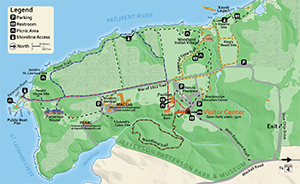
Jefferson Patterson Park and Museum 10515 Mackall Road St. Leonard, Maryland 20685 Phone: 410-586-8538 or Email: [email protected]
Park Grounds and Trails
Hours: Park and grounds are open all year from 7:30 am until dusk, except for New Year's Day, Thanksgiving, and Christmas. Free park admission.
Visitor Center
The Visitor Center is open Wednesday - Sunday from 10:00am - 4:00pm. The building is closed on Thanksgiving Day, and December 13 through January 16.
Exhibit Barn
Tours of the Exhibit Barn can be requested at the Visitor Center or by calling to schedule a tour.
Administration Office
The administration offices are open Monday through Friday from 8:30 am to 5:00 pm. See staff directory for department contact information.
Our Social Media Channels
We're available on the following channels.
Gates of the Arctic National Park and Preserve: The Complete Guide
:max_bytes(150000):strip_icc():format(webp)/SBP89375copyWEB-d65242d5b8cf41e394635f6980b98b8e.jpg)
Things to Do
Where to camp, how to get there, fire safety.
- Weather & Best Time to Visit
Tips For Your Visit
Gates of the arctic national park and preserve.
Visiting Alaska’s rugged landscapes, in the northernmost national park in America, is a trip of a lifetime. The Gates of the Arctic National Park and Preserve, which includes parts of the Brooks Range, is vast—it’s the second largest in the United States—but because there are no roads or established trails in the area, it’s among the least visited national parks in the country. This is as wild as it gets and the park is located completely above the Arctic Circle. If you visit here, your cellphone won’t work, you’ll need to know how to read a map , and it’s essential to be skilled in backcountry wilderness survival. Guiding services are highly recommended as are sightseeing trips with air taxis.
Wilderness advocate and adventurer, Robert Marshall, named the park after seeing the two peaks, Frigid Crags and Boreal Mountain, the gates at the central Brooks Range, leading into the far north Arctic. Towering mountains, taiga, tundra, boreal forests, six national wild rivers, and a large wildlife population—caribou, grizzly and black bears, beavers, wolves, Dall’s sheep, fox, and others—make this Alaska’s definitive wilderness.
You’ll have to do your homework ahead of time to be prepared for time spent in this weathered landscape, full of dark star-filled skies, seemingly endless expanses of rough terrain, and possible wildlife encounters. A floatplane will take you to the shoreline and then you’re on your own unless you’ve made arrangements for an outfitter or guide. Survival skills and wilderness training are essential—this can’t be stressed enough.
Exploring the Rivers
Fishing and floating on the rivers, six of which are designed as wild rivers, are top activities inside the park. In fact, rivers have been used by humans and wildlife in this area for centuries. Fishing should only be catch-and-release, due to the delicate ecosystem, unless you eat what you catch straightaway. Since you’ll need to utilize air taxi services to get to the park, most river travel is done with inflatable canoes, rafts, pack rafts, or other lightweight, foldable watercraft. You’ll, of course, have to be an experienced paddler, completely aware of the conditions, water temperatures and levels, and presence of wildlife. The six wild and scenic rivers include Alatna River, John River, Kobuk River, Noatak River, North Fork Koyukuk River, and Tinayguk River. Learn about the National Park Services’ Wild and Scenic Rivers Program for helpful insight.
Backpacking
Experienced backpackers will love the solitude and challenging terrain as they wander through sections of the over 8 million acres of pristine backcountry and camp and fish near lakes and gravel bars. Because there are no designated trails inside the park, the terrain is difficult and requires bushwhacking through dense vegetation. Be aware that you’ll likely have several streams and rivers that you’ll have to cross, with the highest water levels in spring. Be sure to stick to game trails, rather than create your own bad-for-the-environment social trails. When this isn’t possible, hike in a spread-out formation for minimal impact when traveling in a group. You’ll want to be proficient in topographical map reading and consider bringing along a safety beacon device or GPS. Communication with your air taxi captain is essential as well as they’ll be the ones to pick you up at a designated location and time. The National Park Service has a useful list of guides and commercial visitor service providers.
For hunting, you’ll need to be savvy regarding the State of Alaska Hunting Regulations . To protect the delicate ecosystems, sport hunting is allowed in the Gates of the Arctic National Preserve but not the Gates of the Arctic National Park. You must have all the required hunting permits, licenses and adhere to all the state rules and regulations. Secure permits and learn more at the Alaska Department of Fish and Game . Subsistence hunting, however, is allowed for Alaska native peoples and Alaska’s rural residents.
Mountain Climbing
Technical mountain climbers can expect amazing views while climbing the Arrigetch Peaks, within the central Brooks Range. Float-equipped aircraft is the main way to access Arrigetch Peaks, as well as the Mount Doonerak and Mount Igikpak areas. Avoid using fixed anchors and bolts unless you contact the park for a special use permit.
There are no designated campsites at the national park and preserve. A similar thread rings true here: you must be a proficient backcountry camper to survive in the Alaskan wilderness. Arctic tundra is delicate; therefore, you’ll need to be careful of Leave No Trace principles to protect the ecosystem. Camp on the more resilient gravel bars, instead of soft mosses and grasses, being mindful of water levels.
Because you’ll be in big bear country, make sure you set up your kitchen and eating area at least 100 yards from your sleeping area and never bring odorous items (toothpaste, food, deodorant, etc.) into your tent—store items in a bear-resistant food container (BRFC). Campfires are often impractical and damaging to the environment so be prepared to cook your meals on a portable backpacking stove. Learn more about food storage and bear safety on the park’s website.
No roads or trails lead into the park lands. To access the park, you’ll have to fly or hike in, making arrangements ahead of time. Arrive in Fairbanks, then take a small plane, which operates daily, to one of the gateway communities: Bettles, Anaktuvuk Pass, or Coldfoot. The most common mode of transportation is an air taxi; however, you can hike in from the Dalton Highway or from the village of Anaktuvuk Pass (you will have to cross rivers and streams). When you arrive in Fairbanks, be sure to visit the Fairbanks Alaska Public Lands Information Center.
- Bettles: This is a tiny bush village, with no road going in or out, and to reach it, you’ll have to take one of the daily flights from Fairbanks. Once there you can visit the store, post office, and park visitor center for minor needs. From Bettles, you can take an air taxi into the park.
- Anaktuvuk Pass: To travel through Anaktuvuk Pass, you’ll first need to ask for permission from the Village Council via email . As with Bettles, there is no road that goes in or out. You can fly into this Nunamuit village on one of the daily flights from Fairbanks and then reach the park via foot from the airstrip. You’re welcome to walk through the native land, which surrounds the airstrip, however you’ll have to ask for permission should you want to camp. Visit the Nunamuit history museum, small store, and post office while there.
- Coldfoot: From Fairbanks, drive 280 miles north on the Dalton Highway, or fly into the village. There’s an air taxi, motel, store, café, and post office in Coldfoot. Campsites and trails are available here as well. The neighboring town of Wiseman has two lodges for guests. From Coldfoot, fly or hike into the park.
Wildfires do happen inside the park, even though summers are brief, and winters are long, and wildfire safety is something to be aware of. Most fires occur in the forested areas, in the lower third of the park, and are allowed to take their natural course with minimal fire suppression efforts. Be sure to follow the guidelines regarding campfires, which can change depending on several factors each year.
Weather & Best Time to Visit
The arctic and sub-arctic weather can change rapidly. Always bring appropriate layers and sun protection, based on the season. Be prepared for extremely cold winters, relatively mild summers, low precipitation each season, and high winds. Mid-June—September is the best time for hiking and backpacking. November—March is the best time to visit for a chance to see the aurora borealis.
- The park is open 24 hours a day, 365 days per year.
- The park is free to enter.
- Contact the park prior to arrival to learn about advisories and safety updates and stop in at one of the park’s visitor centers for backcountry information.
- Submit a Backcountry Registration Form for safety.
- Bring a hat, bug spray, and protection from mosquitoes and sun.
- Hundreds of species of birds have been seen in the park—migratory as well as year-round. You can see—and hear—hawks, eagles, owls, warblers, gulls, sparrows, grouse, and more. You’ll have the best chance of spotting them in the early mornings and early evenings and because the sun never fully sets in the summertime, the earlier your wake up or the later you stay up, will give you the best chance.
The Complete Guide to Alaska's National Parks
Denali National Park and Preserve: The Complete Guide
Your Trip to Alaska: The Complete Guide
How to Spend One Week in Alaska
Should You Visit Alaska by Land or on a Cruise?
Where to Go in 2021: 10 Future Trips You Can Start Planning Now
25 Best Things to Do in Alaska
The Best Staycation in Every State
10 Crowd-Free Alternatives to America's Most Iconic National Parks
The Best US National Park for Every Outdoor Activity
The Most Remote Destinations for Adventure Travelers
Serengeti National Park, Tanzania: The Complete Guide
The Best Outdoor Activity in Every State
Glacier National Park: The Complete Guide
Lewis and Clark Sites in Montana
Yosemite National Park: The Complete Guide

It’s National Park Week! Your ultimate guide to visiting a National Park for the first time
These essentials will make your National Park visit a breeze.

Updated April 25, 2024
Recommendations are independently chosen by Reviewed's editors. Purchases made through the links below may earn us and our publishing partners a commission.
Whether you're headed to the extreme heat of Death Valley or the mountains of Glacier, these packing essentials will help you be ready for your National Park excursion, even as a first-timer.
Sign up for our newsletter.
Enter your email:
Thanks for signing up.
Your national park checklist .
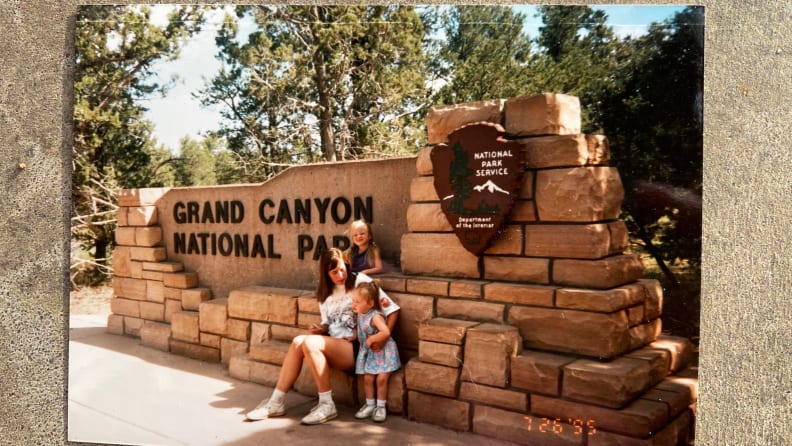
My mom keeps a close eye on me and my cousin Emily while at Grand Canyon National Park.
Protection from the elements
Speaking of rain, every park has different weather to consider. Look up the weather patterns for the time period you'll be there and plan accordingly.

Look for environmentally friendly sunscreens for your park visit. The Haruharu Wonder Daily Sunscreen is reef safe.

Grab a great sun hat to keep the sun off your head, neck, and face.

Stay dry with this lightweight rain jacket.

Keep yourself bug bite free with this insect spray.
Comfortable and fast-drying clothes and shoes

These fast-drying wool socks are perfect for hiking in any weather and will keep water and sweat from lingering.

These pants can convert from pants to shorts, making them perfect for parks with extreme temperature and weather changes.

Comfortable walking sneakers like these are a must for any amount of walking in parks.

You will not need thermal clothing for every park, particularly if you won’t be camping or hiking. If you are though, thermal underwear is perfect for colder parks and prolonged time outdoors.
Ways to keep your devices charged
It may seem counterintuitive to focus on charging electronics when you're off to your first National Park. After all, one of the best things about them is how easy it is to disconnect from our digital, fast-paced world, slow down, and really enjoy the natural world around you. However, for most of us these days, our camera is the same as our phone, and these moments will definitely be ones you don't want to forget.

Charge your phone while you’re on the road with this plug-in charger.

This portable battery pack lets you charge your phone anywhere.
Maps and guidebooks for when your devices stop working
If you're anything like me, you're used to relying heavily on your map app and Google when figuring out routes to take and places to visit. However, no matter how prepared you are with your tech, you're still at the mercy of nature: in most National Parks, cell service becomes extremely spotty to non-existent. Plus, there's always the chance that you lose your phone or charger in an ill-timed stumble or fall.
Note that at nearly every park, the ranger at the entrance will offer you a map. Yes, paper maps still exist, and you should hang onto it! They're free and call attention to the must-see features of the park while helping you avoid getting lost. The visitor center is also a great safe place should you get lost or lose your devices. You can get maps of individual trails there and ask park rangers for advice about the best places to go.

If you want to see the map ahead of time, the National Geographic illustrated maps are a great way to plan your routes.

Grab a trail guide from the ones who know the trails best—the parks themselves.
A first aid kit
When hiking or camping, always have some type of first aid on you. Ideally, you'll never need it, but it's one of those situations where being over-prepared will always be better than being under-prepared. If you don't have room in your pack (but you should!) or will be close enough to populated areas, even just tucking a few Band-Aids and some disinfectant into your pocket can be a good compromise.

This 330-piece first aid kit is comprehensive and perfect for the car or campsite.

Bring first aid on hikes easily with this mini, crush-resistant travel kit.
A backpack to carry it all

A lightweight, waterproof backpack is a great way to store all your stuff.

For serious hiking, a backpack like Loowoko can help you carry everything you need.
Snacks and drinks
There aren't very many places (or any places, depending on the park) to buy food or drinks within a National Park. Because of this, it's essential to plan your meals and snacks so that you always have a way to stay fed and happy.
There are, however, plenty of places in the park to fill up a water bottle and stay hydrated so a refillable water bottle is a must. A cooler is also a good idea (there are places in most parks to buy ice near campgrounds and visitor areas). Just be sure to know whether bears are a factor with the park you're headed to. If they are, take the appropriate precautions.

This collapsible, leak proof, insulated cooler is convenient for hiking or road trips.

Keep your food and drinks cool with this bear-proof cooler.

Staying hydrated is a must in any park, particularly when doing physical activities like hiking.
Hiking gear

For serious hikers, a solid pair of durable, waterproof hiking boots will help you stay comfortable and safe on the trails.

This plastic whistle is a reliable way to draw attention in an emergency no matter the weather.

These lightweight trekking poles are a great way to keep your balance on any terrain.
Camping gear

This flashlight can convert to a lantern and even charge your phone in an emergency.

Having a reliable, waterproof, easy to set up tent should always be a priority while camping.

Sleeping bags are a classic for a reason—they’re compact, cheap, and work for most weather.
What are National Parks?
What is national park week, can you bring pets to national parks .
That said, pets are only allowed in certain areas of some parks. Generally, if it is a developed area (think roads, paved walkways, buildings) they're okay to be outside with you walking around. However, not all park buildings allow pets and many trails do not allow pets for their safety and yours.
Keep a close eye on your pet for their safety and yours

A leash is a must for any pet that is traveling to a park with you.

Always have a poop bag handy with a reusable dispenser that can attach to your leash.

Smaller pets can travel in backpack-style carriers—just be sure they have proper ventilation.
Hydration matters just as much for them as for you
Be sure to plan for how your pet will stay hydrated just as you will. For hikes, it can be useful to carry a larger water jug that you can use to refill your water bottle and your pet's bowl.

This water bottle comes with an attachment that will work as a bowl in a pinch for most dogs.

These lightweight water bowls fold flat to make them easy to pack for any hike.
Related content

Prices were accurate at the time this article was published but may change over time.
Everything you need to know about visiting Shenandoah National Park

When Virginia's Shenandoah National Park was established on Dec. 26, 1935, it became the 22nd federally designated tract of land considered special enough to preserve for the American people.
But unlike many fabled national parks in the U.S. — where glacier-capped peaks protrude from meadows and granite monoliths rise from valley floors — Shenandoah National Park's uniqueness lies not just in its natural landscape but also in its history.
For thousands of years, the Iroquois, Shawnee, Catawba, Cherokee, Delaware and Susquehannock nations hunted and gathered in the fertile Shenandoah Valley against a backdrop of the ridgeline now encompassed within Shenandoah National Park.
By the mid-18th century, European settlers began moving into the valleys below the Blue Ridge Mountains; they were logging, building saw and grist mills, raising cattle, and harvesting chestnuts and apples.
Now, well over a million people visit the 100-mile ridge annually to hike, fish, climb and explore the many off-shooting ridges that overlook the rolling foothills of the Piedmont plateau to the east and the Shenandoah Valley to the west.
Skyline Drive traverses the 4,000-foot ridge, providing easy access to countless pull-offs, scenic vistas and trailheads that lead hikers toward the park's best-kept secrets.
Before you go
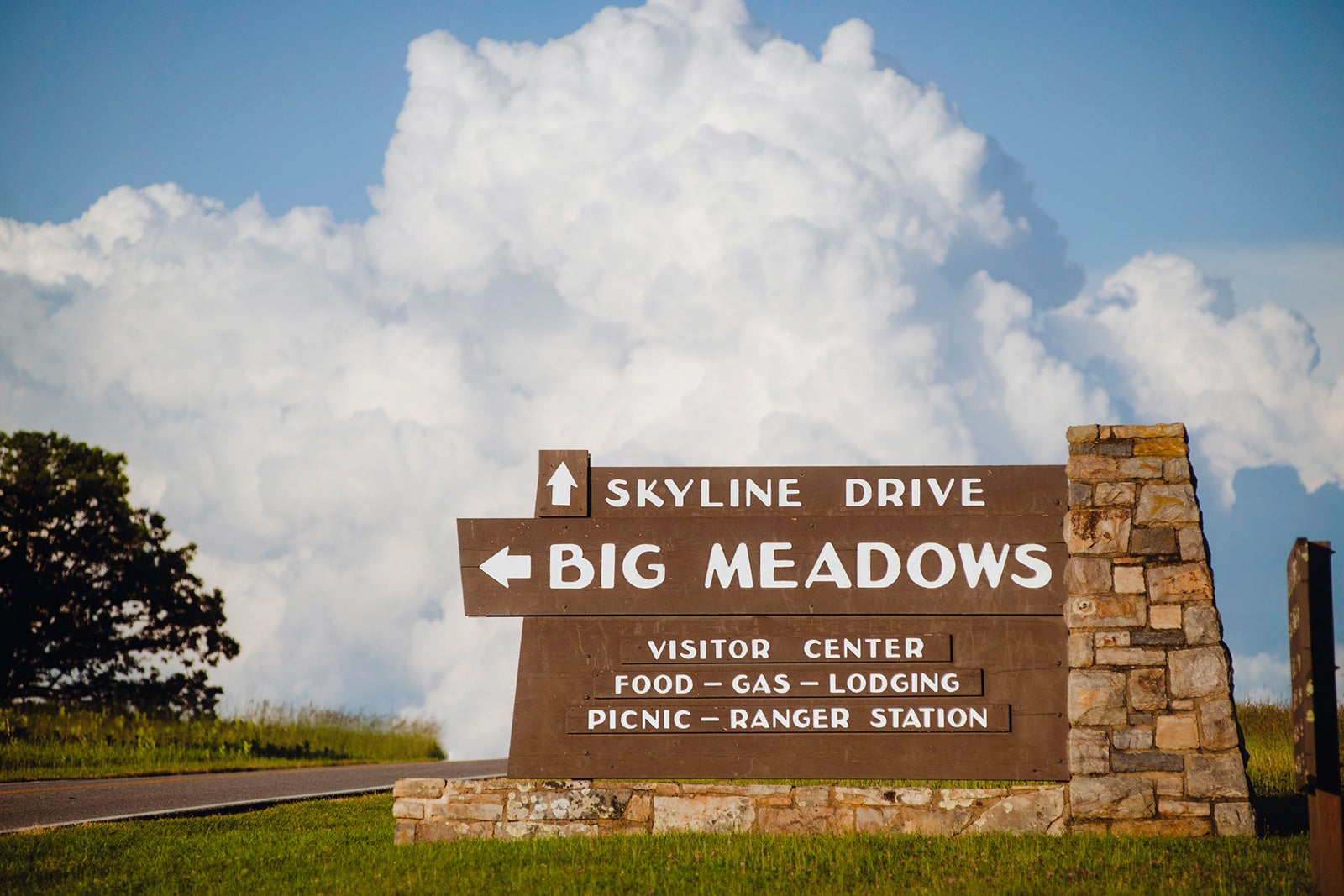
With just one road — Skyline Drive — cutting through the park's center, Shenandoah National Park can feel more crowded than some of its busier counterparts. Visiting during non-peak seasons and mid-week can help you avoid traffic and heavy crowds.
Related: Tips for visiting the busiest national parks
Many of the park's viewpoints can be seen from Skyline Drive, contributing to its busier feel. However, the best way to experience the park is by lacing up your hiking boots and heading into the backcountry. If you intend to camp, you should reserve a campground or get a backcountry camping permit in advance, then hit the trails from there.
The park's 200,000 acres are divided into three districts, and while all three can be done in a single trip, it's good to have an idea of which district you want to be based in.
Despite its proximity to Washington, D.C., the North District tends to be a bit quieter and offer a more secluded feel than the others. In contrast, the Central District — which has some of the higher peaks and popular destinations like Old Rag Mountain — is relatively busy. Like the North District, the South District also tends to be a bit quieter.
Getting there and around
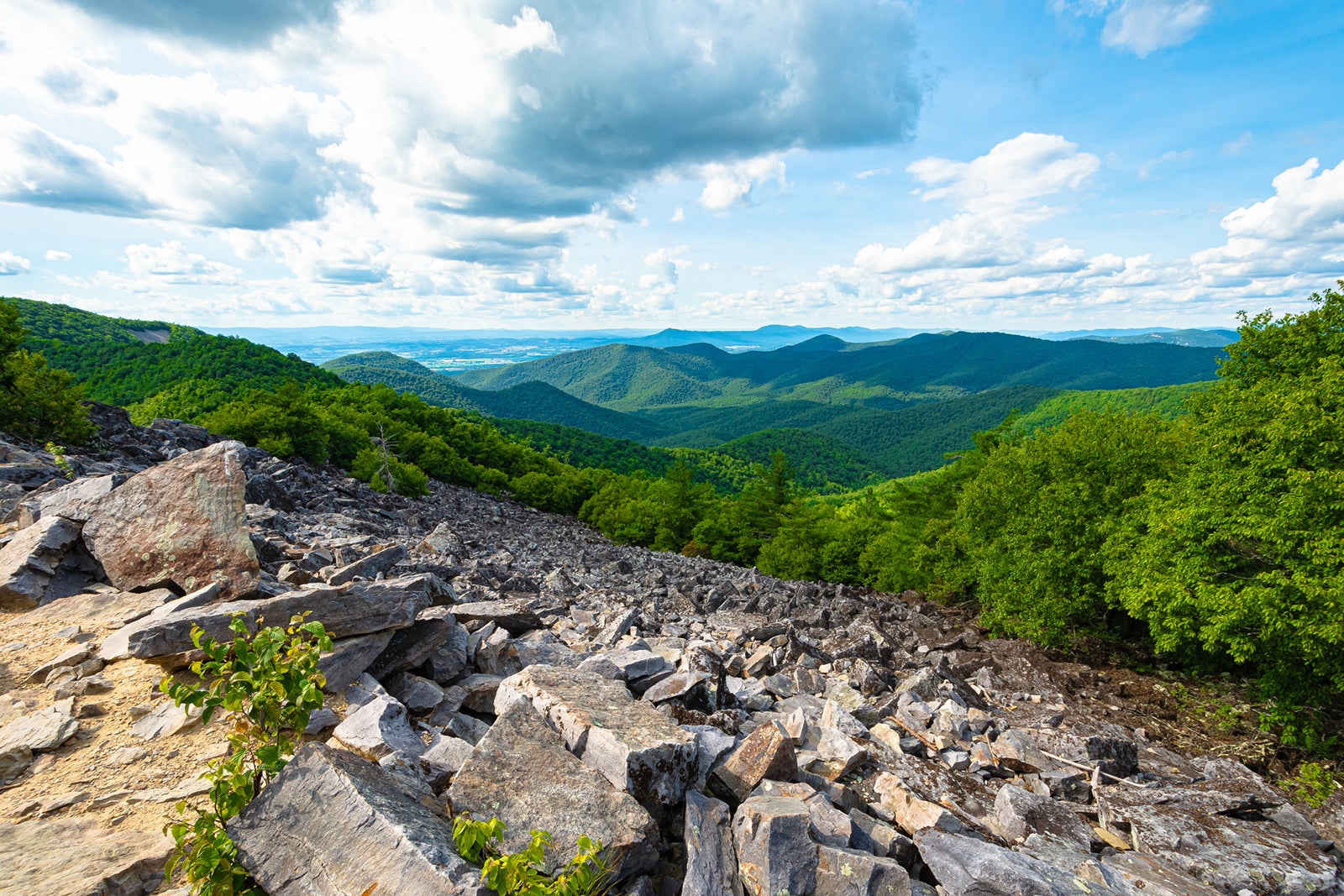
There aren't any park-run shuttle services in Shenandoah, but the entirety of the park is easily accessible by car. The northernmost entrance of the park in Front Royal, Virginia, is just 56 miles from Dulles International Airport (IAD).
Once you're in the park, the 105-mile Skyline Drive traverses its entire length, passing most of the attractions and trailheads along the way. Make sure to grab an information pamphlet, which includes a map, from a visitor center at the start of the trip.
Spending a little time at the visitor centers will also allow you to familiarize yourself with the park. You can learn about its flora and fauna, find out about any closures, explore available guided nature walks and programs, and get some tips from the people who know the park best.
The best time to visit
Like any national park, the "best" time to visit depends on your priorities. During early October, deciduous trees at higher elevations become illuminated with reds, oranges and yellows; the bright colors work their way toward lower elevations as the month progresses. It's a spectacular scene that comes with crowds, especially during peak foliage weekends.
Related: 10 of the best national parks to visit in the fall
Once the leaves fall and cold sets in between November and February, crowds dissipate, and opportunities to find solitude become endless. While temperatures tend to hover between the upper 20s and upper 30s Fahrenheit, it can snow at higher elevations, forcing temporary closures of sections of Skyline Drive.
Front-country campgrounds in Shenandoah are closed during winter, so lodging is confined to backcountry camping or hotels and lodges.
Early spring can be one of the best times to visit Shenandoah National Park. Wildflowers and trees begin to bloom, days become warmer and longer, and the summer crowds have not yet arrived. Weather can vary greatly, though, making planning a bit more difficult. The lowlands can sometimes be warm enough for shorts and a T-shirt, while higher elevations can still be covered in snow through March.
Memorial Day marks the unofficial start of summer, bringing warmer temperatures, longer days and crowds. Luscious greens take over the landscape, and cascading streams filled with brook trout beckon fly fishermen.
Thru-hikers taking the Appalachian Trail from Georgia to Maine are often seen hiking the 100 miles of trail that traverse the park. So, it can be a great time to meet interesting people. (Make sure to keep some cold beers or sodas around to share — it's always appreciated.) Although it's the most crowded time of year, you can still find some solitude in the forest by visiting mid-week, avoiding the most popular trails and spending time in the northern and southernmost parts of the park.
What to see and do
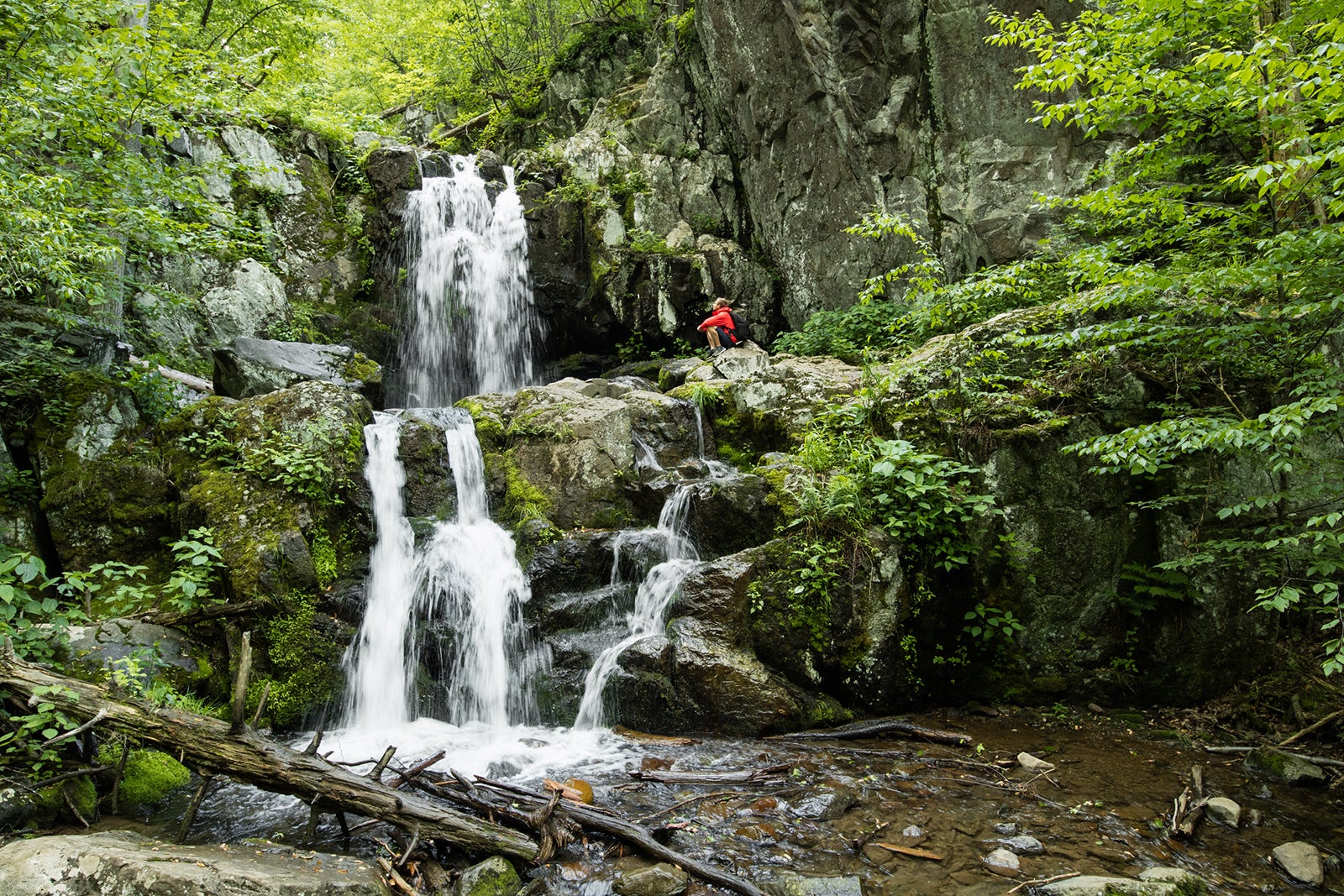
Old Rag Mountain is one of the most popular hikes in the park — and rightfully so. There are several ways to reach the summit, but the 9.4-mile Old Rag Circuit is one of the most exciting (and crowded). The hike combines a mix of relaxed trails through the forested, steeper sections of trail and strenuous rock scrambles over the 2,348 feet of elevation gain.
Hikers are rewarded with 360-degree views at the summit, perfect for enjoying a snack before the hike down. You must obtain a day-use ticket in advance from March 1 through Nov. 30.
In the North District of the park, the 7.4-mile Little Devils Stairs Loop is an all-day, full-value hike; it passes through a gorge with cascades and waterfalls as well as through an old-growth forest, yielding occasional views along the way. On the southern end of the park, the 3.4-mile hike to Chimney Rock features a granite outcropping overlooking the valley below.
With more than 15,000 feet of uphill on a meandering wooded road with periodic vistas, Shenandoah's Skyline Drive is a road biker's dream. Some cyclists choose to ride the entire 105 miles of the road, arranging for a shuttle or stashing a car at either end of the park; others prefer a more leisurely out-and-back from various starting points along the way. There is also a 1-mile section of gravel riding on the Rapidan Fire Road in the Big Meadows area.
Rock climbing
At over a billion years old, the Blue Ridge Mountains are some of the oldest in the world. Over the years, glacial activity and erosion have exposed pristine granite, some of which can be found within Shenandoah National Park and serve as a playground for rock climbers.
Related: The ultimate Blue Ridge Parkway road trip
Scattered throughout the park, boulder fields present challenges for every skill set, but the two major roped climbing areas are Little Stony Man and Old Rag Mountain. The latter requires a more grueling approach and advanced climbing skills.
Unless you're already an experienced outdoor climber, the best way to get the most out of climbing in Shenandoah is by booking a trip with a guide service like Blue Ridge Mountain Guides.
From afar, Shenandoah National Park might not appear to have the dramatic terrain that would be home to countless waterfalls. But hidden in deep hollows, along streams that twist around boulders and plunge over granite outcroppings, there are enough waterfalls to keep visitors busy for a lifetime. The best time to visit the park's waterfalls is during spring or after a period of heavy rain (before the hot and dry summers reduce many of them to a trickle).
At 93 feet, Overall Run Falls is the tallest in the park reachable via a strenuous 5.1-mile round-trip hike through a designated wilderness area. The hike to Dark Hollow Falls is much shorter and less strenuous, but it can also get relatively crowded.
Fly fishing
Shenandoah National Park is home to more than 70 boulder-strewn streams that cascade through thick forests toward the valley below, making it one of the East Coast's premier fly fishing destinations. From March through May, native brook trout cruise the deeper emerald-colored pools, sipping freshly hatched mayflies from the water's surface. This makes it the prime time for fly fishermen to visit.
You can reach most of the best spots by parking at trailheads along Skyline Drive and hiking down toward the lower stretches of streams. While online searches can yield specific spots to check out, simply grabbing a map and following a random stream downhill is often the best way to explore. To start, check out a few popular streams like Big Run or the Rapidan River.
Where to stay
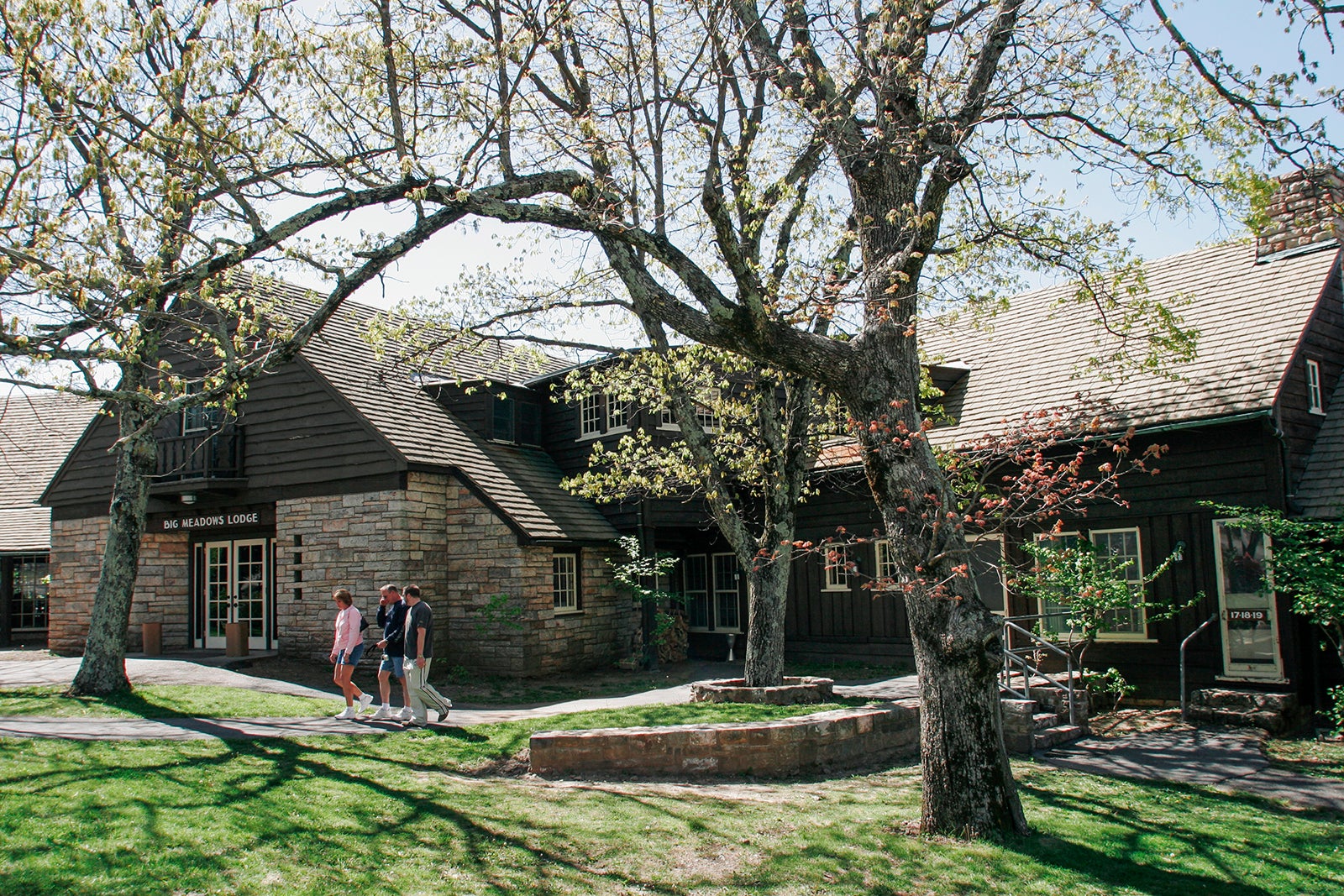
At 3,680 feet, Skyland Lodge is a 19th-century lodge at the highest point on Skyline Drive. This historic mountain retreat has been renovated over the years to feature premium and traditional rooms, suites, cabins and pet-friendly rooms across 28 buildings. Not only does the lodge offer sweeping views of the valley from its property, but its location is perfect for accessing some of the park's most popular trails. Rates start from $196 per night.
Built in 1939 with stones from Massanutten Mountain and native chestnut trees, Big Meadows Lodge is another lodge with similar accommodations to Skyland, including cabins, suites and standard rooms. As the name suggests, the lodge sits adjacent to a large meadow, perfect for stargazing or viewing wildflowers when they bloom in spring. In addition to 72 cabins and 29 traditional rooms, the property features a taproom with local beers, perfect for relaxing after a long day on the trails. Rates start from $127 per night.
Shenandoah National Park has ample opportunity for backcountry camping — a unique opportunity that requires self-reliance and rewards visitors with tranquility they can't find at the drive-in campgrounds. But for those who might not be comfortable or interested in hauling camping gear into the woods, the park does have five campgrounds within its boundaries.
Matthews Arm Campground — which offers a mix of reservable and first-come, first-served sites — is the first you come to when entering the park from the north. Big Meadows, in the Central District, requires reservations and is conveniently near some of the park's most popular hikes.
The Lewis Mountain Campsite is just south of Big Meadows, but it's much quieter and requires self-registration once you arrive. Both the Loft Mountain and Dundo Group campgrounds are in the southern part of the park; the former boasts views to the east and west and the latter is available only to groups. Loft Mountain has both first-come, first-served and reservable sites.
Where to eat

Located within Shenandoah National Park, both the Skyland and Big Meadows lodges offer menus that feature regional dishes like venison bolognese and shrimp and grits. The nearby towns of Front Royal and Charlottesville are both worth a visit in their own right.
The small city of Charlottesville has a college-town vibe thanks to the University of Virginia, but it also has an unassuming culinary scene. Check out the Dairy Market Charlottesville , a food hall that opened in 2019 in the historic Monticello Dairy Building. Grab a local beer at the Starr Hill Brewery or a sandwich from Citizen Burger Stand . The nearby Ridley , which is in the Draftsman Hotel, offers unique and traditional takes on Southern food, such as shrimp and grits and fried green tomatoes.
At the northern entrance of the park lies Front Royal, which is a bit quieter than Charlottesville but still has plenty of restaurants, wineries and breweries to choose from. Osteria Maria is an Italian restaurant that offers fresh pasta made in-house each day. Vibrissa Beer and Kitchen is a hip, modern brewery complete with a taproom, beer garden and full kitchen. Their menu is diverse, with options ranging from country-fried steak to pork belly miso ramen.
Before heading to Shenandoah, familiarize yourself with the seven "Leave No Trace" principles that will help you to be a conscientious and responsible user of our outdoor spaces. While this is important any time you head into the woods, it's especially important in places like Shenandoah and other national parks that experience high visitation.
When camping, proper food storage is critical — especially during spring, summer and fall when black bears are out and about looking for an easy meal. Ticks can also be an issue, so make sure to pack plenty of bug spray, especially if you plan on hitting the trails.
If you plan to bring a pet along (Shenandoah is one of only a handful of national parks that allow pets), make sure to comply with their leash law, and don't leave little gift bags around for the next hiker to find.
It's also worth catching a sunset from one of the viewpoints on Skyline Drive and stargazing from Big Meadows while you're in the park. Despite being relatively close to Washington, D.C., light pollution isn't much of an issue here, so stargazing from the top of the ridge can be a spectacular experience.
Related reading:
- Key travel tips you need to know — whether you're a beginner or expert traveler
- The best travel credit cards
- Where to go in 2024: The 16 best places to travel
- 6 real-life strategies you can use when your flight is canceled or delayed
- 8 of the best credit cards for general travel purchases
- 13 must-have items the TPG team can't travel without
How many people visit our America's national parks? Graphics explain
Each year, the National Park Service welcomes millions of visitors. Since the agency started tracking attendance in 1904, more than 15 billion people have paid visits to the National Park System .
With 63 national parks spanning the United States, visitors have their fair share of natural beauty to explore. From Acadia National Park in Maine to Olympic National Park in Washington and California's Yosemite to Tennessee and North Carolina's Great Smoky Mountains, each park provides a unique experience for tourists.
“Our national parks tell our shared American story. I'm glad visitors are finding hidden gems, exploring in the off-season and finding new ways to have a great time in our national parks,” said National Park Service director Chuck Sams in a statement.
On Saturday April 20th, all fees to visit national parks will be lifted to celebrate the first day of National Park Week . Last year, the first day of national park week coincided with Earth Day.
How many people visit national parks each year?
The National Park Service said more than 325 million people visited the parks last year, up 4% from 2022. That includes visits to more than 400 parks run by NPS. After the COVID-19 pandemic caused a drop in visitors, the total number of visitors has been on an upward trend. A study found that in April 2020, visitation to U.S. national parks decreased by about 87%, due to temporary closure of some parks.
In 2023, 38% percent of people visited recreation parks, 32% went to historical and cultural parks and 30% went to nature parks, according to NPS.
What are the most visited national parks?
Great Smoky Mountains is the most visited national park in America, by far. Last year, it drew nearly three times the visitors as the second-most visited park, Grand Canyon , according to National Park Service data .
These were the 15 most visited national parks in 2023:
- Great Smoky Mountains in North Carolina and Tennessee - 13,297,647
- Grand Canyon in Arizona - 4,733,705
- Zion in Utah - 4,623,238
- Yellowstone in Idaho, Montana, Wyoming - 4,501,382
- Rocky Mountain in Colorado - 4,115,837
- Yosemite in California - 3,897,070
- Acadia in Maine - 3,879,890
- Grand Teton in Wyoming - 3,417,106
- Joshua Tree in California - 3,270,404
- Olympic National Park in Washington - 2,947,503
- Glacier National Park in Montana - 2,933,616
- Cuyahoga Valley in Ohio - 2,860,059
- Indiana Dunes in Indiana - 2,765,892
- Hot Springs in Arkansas - 2,502,967
- Bryce Canyon in Utah - 2,461,269
From Acadia to Zion: What travelers should know about each of America's national parks
Answers to your biggest park questions: What is the most visited national park in the US?
Where are the national parks located?
All 50 states are home to other National Park Service units , like national battlefields and seashores, which are sometimes called parks.
The National Park System currently has 429 units. The most recent addition is the Amache National Historic Site in Colorado. Travelers can find sites by state on the National Park Service’s website .
What to know about National Park Week
National Park Week kicks off April 20 with free entry to every national park in America.
That’s not just capital NP national parks like Grand Teton and Olympic , but all 429 sites within the National Park System , ranging from national historic sites to national scenic trails.
Entry fees are only waived that first day, but there are special activities planned throughout National Park Week (and many sites don’t charge entry fees anyway).
National Park Week spans nine days. It runs from April 20 through April 28.
Each day will spotlight a different parks-related theme.
- April 20: Discovery
- April 21: Volunteers
- April 22: Earth Day
- April 23: Innovation
- April 24: Workforce Wednesday
- April 25: Youth Engagement
- April 26: Community Connections
- April 27: Junior Ranger Day
- April 28: Arts in Parks

The 49 best photo spots in Moscow
Navigate forward to interact with the calendar and select a date. Press the question mark key to get the keyboard shortcuts for changing dates.
Navigate backward to interact with the calendar and select a date. Press the question mark key to get the keyboard shortcuts for changing dates.

1 The Moscow Kremlin
2 Red Square

3 Gorky Central Park of Culture and Leisure
4 st. basil's cathedral, 5 bolshoi theatre.

Track your travel spending and split costs with friends
Plan your trip. Keep your budget organized. Split the cost between tripmates. Wanderlog does it all.

Don’t forget to pack anything
Stay organized with a to-do list, packing list, shopping list, any kind of list.

16 Grand Kremlin Palace
17 state historical museum, 18 public museum of the moscow metro, 19 cafe pushkin, 20 armoury chamber, 21 vorob'yevy gory, 22 all-russian exhibition center, 23 moscow zoo, 24 alexander garden, 25 sokolniki park.

All travel reservations in 1 place
Never dig through your emails again — access all your flights, lodging, and any reservations in 1 place.

26 Muzeon Park of Arts
27 ostankino television tower, 28 patriarch's ponds, 29 neskuchny garden, 30 museum of soviet arcade games, 31 dormition cathedral, 32 the carlton, moscow, 33 monument to minin and pozharsky, 34 annunciation cathedral, 35 russian state library.

Perfect for road trips
See time and distance between places, and optimize your route to get the most of your day.

36 Winzavod
37 museum of the history of vodka, 38 komsomolskaya, 39 moscow state university, 40 poklonnaya hill, 41 ostrov mechty (dream island), 42 moskva river, 43 business district "moscow silk", 44 vorob'yevy gory, 45 memorial eternal flame.
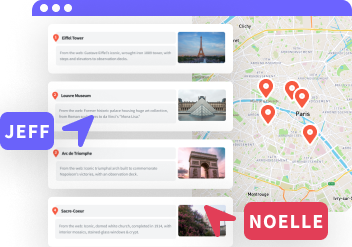
Collaborate with friends in real time
Plan along with your friends with live syncing and collaborative editing.

46 STREET ADVENTURE
47 underground gallery, 48 old arbat hostel, 49 moscow school of painting, sculpture and architecture, top searches in moscow, popular road trips from moscow, what's the weather like in moscow.
It depends on when you visit! We've compiled data from NASA on what the weather is like in Moscow for each month of the year: see the links below for more information.
- Weather in Moscow in January
- Weather in Moscow in February
- Weather in Moscow in March
- Weather in Moscow in April
- Weather in Moscow in May
- Weather in Moscow in June
- Weather in Moscow in July
- Weather in Moscow in August
- Weather in Moscow in September
- Weather in Moscow in October
- Weather in Moscow in November
- Weather in Moscow in December
All road trips from Moscow
- Moscow to London drive
- Moscow to Paris drive
- Moscow to St. Petersburg drive
- Moscow to Berlin drive
- Moscow to Prague drive
- Moscow to Amsterdam drive
- Moscow to Budapest drive
- Moscow to Vienna drive
- Moscow to Istanbul drive
- Moscow to Florence drive
- Moscow to Venice drive
- Moscow to Stockholm drive
- Moscow to Milan drive
- Moscow to Krakow drive
- Moscow to Copenhagen drive
- Moscow to Warsaw drive
- Moscow to Helsinki drive
- Moscow to Munich drive
- Moscow to Brussels drive
- Moscow to Tallinn drive
- Moscow to Riga drive
- Moscow to Oslo drive
- Moscow to Turin drive
- Moscow to Hamburg drive
- Moscow to Vilnius drive
- Moscow to Yaroslavl drive
- Moscow to Nizhny Novgorod drive
- Moscow to Kyiv drive
- Moscow to Tula drive
- Moscow to Bruges drive
Explore nearby places
- Likino-Dulevo
- Ivanteyevka
- Orekhovo-Zuevo
- Semyonovskoye
- Ivanovskoye
- Rumyantsevo
- Dzerzhinsky
- Sovkhoz Imeni Lenina
- Dolgoprudny
All related maps of Moscow
- Map of Moscow
- Map of Danki
- Map of Shatura
- Map of Likino-Dulevo
- Map of Uspenskoye
- Map of Gorskoye
- Map of Ivanteyevka
- Map of Reutov
- Map of Domodedovo
- Map of Peresvet
- Map of Vorobyovo
- Map of Bronnitsy
- Map of Orekhovo-Zuevo
- Map of Moskovsky
- Map of Semyonovskoye
- Map of Izmaylovo
- Map of Nikolskoye
- Map of Ivanovskoye
- Map of Marfino
- Map of Govorovo
- Map of Nagornoye
- Map of Mosrentgen
- Map of Bratsevo
- Map of Rumyantsevo
- Map of Mytishchi
- Map of Putilkovo
- Map of Razvilka
- Map of Khimki
- Map of Dzerzhinsky
- Map of Sovkhoz Imeni Lenina
- Map of Dolgoprudny
Moscow throughout the year
- Moscow in January
- Moscow in February
- Moscow in March
- Moscow in April
- Moscow in May
- Moscow in June
- Moscow in July
- Moscow in August
- Moscow in September
- Moscow in October
- Moscow in November
- Moscow in December
Looking for day-by-day itineraries in Moscow?
Get inspired for your trip to Moscow with our curated itineraries that are jam-packed with popular attractions everyday! Check them out here:
- 1-Day Moscow Itinerary
- 2-Day Moscow Itinerary
- 3-Day Moscow Itinerary
- 4-Day Moscow Itinerary
- 5-Day Moscow Itinerary
Best attractions in nearby cities
- Top things to do and attractions in Khimki
Best restaurants in nearby cities
- Where to eat: the best restaurants in Mytishchi
- Where to eat: the best restaurants in Khimki

- Itinerary + map in one view
- Live collaboration
- Auto-import hotels and reservations
- Optimize your route
- Offline access on mobile
- See time and distance between all your places
- Skip to global NPS navigation
- Skip to the main content
- Skip to the footer section

Exiting nps.gov
Entrance passes.
Most of the sites managed by the National Park Service are free to visit, but some require an entrance pass. You may also need a vehicle reservation at a few high-traffic sites.
Frequent visitors, seniors , military, and others may save money on entrance fees with an America the Beautiful—the National Parks and Federal Recreational Lands Pass, also known an America the Beautiful or interagency pass. Review all pass options below and decide which pass is best for you.
Entrance Pass Comparison
National parks that charge an entrance fee require visitors to purchase or obtain a standard pass, park-specific annual pass, or America the Beautiful pass. Visitors only need one of these.
Standard Pass
- For one national park
- Valid for 7 days
- Directly funds the park
Recommended for
One trip to one park
Entrance fees and passes by park
Annual Pass
- For one national park or park group
- Valid for 1 year
- Not available for every park
- Multiple trips to one park
- One or more trips to one park group
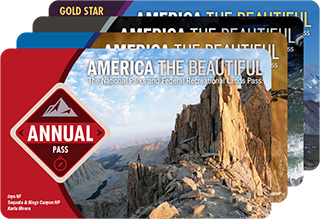
America the Beautiful—the National Parks and Federal Recreational Lands Pass
- Covers entrance fees and standard amenity fees (day-use fees) at Federal recreational sites, including national parks
- 1 year and lifetime options
- Seniors , military, visitors with permanent disabilities
- One or more trips to multiple parks
More about America the Beautiful Passes
Vehicle Reservations
Some highly-visited national parks use a seasonal or year-round timed entry system to manage private vehicle traffic. Reservations are typically made available through recreation.gov on a rolling basis. If you plan to drive into one of these parks while the timed entry system is in effect, we recommend making a reservation well in advance.
Parks with vehicle reservations
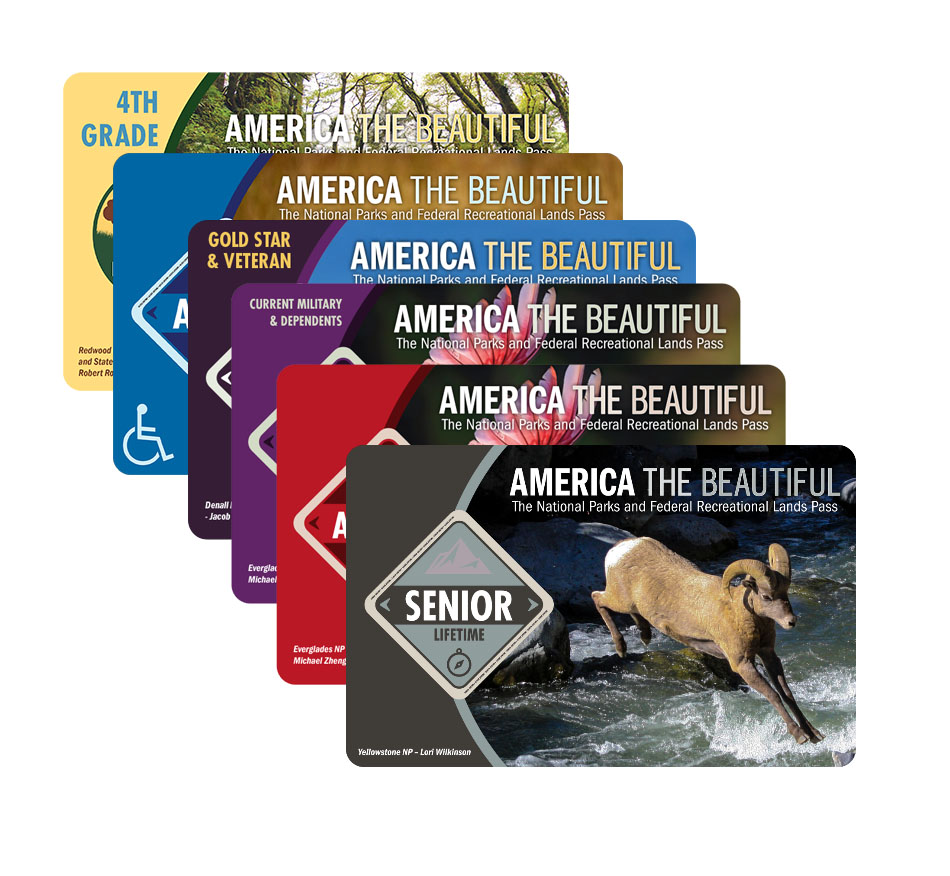
Covers entrance fees and standard amenity (day-use) fees at lands managed by
- National Park Service
- US Fish & Wildlife Service
- US Forest Service
- Bureau of Land Management
- Bureau of Reclamation
- US Army of Corps of Engineers
Depending on the type of entrance fee charged at a site, covers One private vehicle fee or Four per person fees
America the Beautiful Passes are non-refundable, non-transferable and cannot be replaced if lost or stolen . Passholders must show valid photo identification (ID) with each pass.
How to Get an America the Beautiful Pass
In person (recommended).
Passes can be purchased or picked up at over 1,000 federal recreation sites.
Purchase and pickup locations
Order Online, Receive by Mail
To receive your pass by mail, order online at the USGS Online Store or by phone: 1-888-275-8747 , extension 1. Hours of operation are 8 am to 4 pm Mountain Time.
Visiting soon? Pick up a pass when you arrive.
America the Beautiful Passes ordered online through the USGS Online Store may take up to three weeks to be processed and delivered. Get your pass at one of over 1,000 purchase and pickup locations to avoid the wait.
Senior Passes
US citizens and permanent residents ages 62 and older can purchase an annual America the Beautiful—the National Parks and Federal Recreational Lands Pass for $20.00, or a lifetime version for $80.00. Applicants must provide documentation of age and residency or citizenship.
- The Senior Pass may provide a 50 percent discount on some amenity fees charged for facilities and services such as camping, swimming, boat launch, and specialized interpretive services.
- The Senior Pass generally does NOT cover or reduce special recreation permit fees or fees charged by concessioners.
- Passes may not be purchased as gifts since eligible recipient must show proof of eligibility.
Annual Senior Pass
Lifetime senior pass, golden age passports and golden access passports.
Golden Age Passports and Golden Access Passports are no longer sold. However, these passes are still honored according to the provisions of the pass.
We encourage you to exchange your Golden Age/Golden Access Passport for a current Lifetime Senior Pass for free. You can exchange in-person at sites that issue passes. Please bring your old pass and photo identification with you.
Annual Passes and Park Groups
While most annual park passes are limited to one national park, a few sites offer an annual pass valid at multiple national parks, federal recreational lands, or state parks.
Free Entrance Days
Come experience the national parks! On six days in 2024, all National Park Service sites that charge an entrance fee will offer free admission to everyone. Mark your calendar for these entrance fee–free dates in 2024:
- January 15: Birthday of Martin Luther King, Jr.
- April 20: First day of National Park Week
- June 19: Juneteenth National Independence Day
- August 4: Anniversary of the Great American Outdoors Act
- September 28: National Public Lands Day
- November 11: Veterans Day
Your Fee Dollars at Work
All the money from entrance fees remains in the National Park Service, and at least 80 percent stays in the park where it was collected. Learn more about how entrance fees are used to improve the visitor experience .
Last updated: March 25, 2024
Cubs visit Fenway Park for the first time since 2017: 'Awesome, historic'
Notes: lefty justin steele threw in an extended spring training game friday..

The Cubs’ Dansby Swanson celebrates with manager Craig Counsell after scoring against the Boston Red Sox on Friday at Fenway Park.
Maddie Meyer/Getty Images
BOSTON — Cubs president of baseball operations Jed Hoyer pointed out to center field, where the Fenway Park wall comes to a point, and Pete Crow-Armstrong’ s gaze followed the gesture.
“That triangle is so unbelievably deep,” Hoyer explained later.
The decal on the wall indicates that it’s 420 feet. Wrigley Field, by comparison, is 400 feet to center field.
Crow-Armstrong was roaming Fenway’s unique center field for the first time in his major-league career Friday. Hoyer, a former longtime Red Sox executive, had watched more than enough games at the ballpark to pass on exactly how it plays.
The Cubs returned to Fenway on Friday for the first time since 2017. It wasn’t only rookies who were playing in the storied building for the first time.
“I’m excited to go on the field there,” second baseman Nico Hoerner said. “Obviously, you get there a little early, walk around, go out to the [Green] Monster. Still a fan of the game, obviously, so it’ll be really exciting.”
Hoerner was supposed to play in the Cape Cod League’s annual showcase at Fenway Park — where players from the college summer ball league take batting practice and go through a workout on the field — in 2017. But it was rained out, he said.
Left fielder Ian Happ had better luck with the weather when he was in the Cape Cod League. But Friday marked the first time he’d played a competitive game at the Red Sox’ park.
“I think it’s awesome, historic,” Happ said. “It just feels a lot like Wrigley when you walk through the concourse, and everything’s green. It’s cool.”
Fenway Park, which opened in 1912, is the oldest ballpark in MLB. Wrigley Field, which opened two years later, ranks No. 2. Both rise out of dense sections of their respective cities. And the city streets give them their unique dimensions.
The Cubs play a three-game set against the Red Sox this weekend. The Cubs entered the series with a 5-4 record at Fenway.
- How Cubs’ Shota Imanaga helped steady a rotation tested by injuries
Offense filling in
Hoyer addressed reporters Friday for the first time since center fielder Cody Bellinger landed on the 10-day injured list with fractured ribs.
His injury, in the Cubs’ series opener against the Astros Monday, was a blow to an offense that was already without Seiya Suzuki , their hottest hitter to start the year. But the Cubs swept the three-game series against the Astros.
“What I really liked about our offense at the beginning of the season was it felt like the lineup was really long and we had some depth,” Hoyer said. “And so now we’re sort of pushing that depth.
“And having some of the young players come up and contribute is really valuable. And if they can have some success, I think that’ll carry us a long way throughout the season because we’re going to need their contributions throughout. I mean, Seiya and Cody’s injuries are not going to be the last injuries we’re going to face.”
Steele’s extended spring start
Left-hander Justin Steele (strained left hamstring) threw 47 pitches in 2⅓ innings Friday in extended spring training. He will remain in Arizona to continue his rehab, according to the team.

Disney Park Now an Emergency Scene: Firetrucks, Police, First Responders Swarm as Thousands Watch
in Disney Parks , Disneyland Paris

Today, one Disney park was taken over by every medical vehicle imaginable, from firetrucks to ambulances to police and more, as the beloved Main Street, U.S.A., shut down entirely with thousands surrounding the area nearby.

When you visit a Disney park during the Halloween season, you typically will expect to see Halloween decor throughout the park, and perhaps some spooky touches to the daily operations. For example, during Halloween at Disneyland Paris, Disneyland Park adds a fall parade called Mickey’s Halloween Celebration that celebrates both the haunted aspect of the fall season, as well as the Thanksgiving holiday and the changing of the season.
Plus, ghosts take over the theme park as statues are added down Main Street, U.S.A., with scarecrows filling Frontierland!
At Walt Disney World, while there is decor at Magic Kingdom, the specials haunting begin during the extra-ticketed Mickey’s Not-So-Scary Halloween Party event

Then, as things get chillier in the air and the Christmas holiday season begins, we see the theme parks once again transform and acknowledge the holiday in full form.
That being said, it is not only the major holidays that get special attention at the Disney parks, but the smaller ones as well.
Today marks the official date of World Safety Day for Health at Work. While the holiday won’t get you a day off of work on April 28, it is a day to spread awareness of workplace safety while acknowledging our first responders who are there to keep us safe.
The concept of Safety Day originated with the International Labour Organization (ILO) in 2003 and has since evolved into a worldwide observance. This significant event aims to advocate for the prevention of work-related accidents among individuals and organizations.
In June 2022, the International Labour Conference (ILC) made a decision to incorporate ‘a safe and healthy working environment’ into the ILO’s framework of fundamental principles and rights at work, as reported by the ILO.
In order to celebrate, Disneyland Paris decided to start their very-own original World Safety Day parade at Disneyland Park.
Disney guests InsideDlpCastle shared some of the parade, as we can see a mix of safety vehicles alongside Disney characters such as Zootopia’s Nick Wilde (who plays a cop in the film) and character floats to make up the World Safety Day parade.
It’s Nick who closes this Pre-Parade for the World Day for Safety and Health at Work! 🚒
🚨C'est Nick qui cloture cette Pre-Parade de la journée mondiale de la sécurité et de la santé au travail !🚒 pic.twitter.com/np0cNd9uM6 — InsideDlpCastle (@InsideDlpCastle) April 28, 2024
This parade is not something that is being conducted at the other Disney parks today, making it unique to Disneyland Paris. It is also the only day of the year in which guests need not panic at a firetruck blazing down the middle of Main Street, U.S.A. The last time we saw a fire truck doing just that in a non-parade format was a few years ago at Disney World when Cinderella Castle at Magic Kingdom had a small bushfire.
It was stated that a cigarette butt is what started that fire. Smoking is now prohibited in the American Disney theme parks. However, there are designated areas in Disneyland Paris.
InsideDlpCastle also shared Judy Hopps cruising down Main Street, U.S.A., alongside a police officer.
🚨 Today is World Day for Safety and Health at Work! Today all professions in these fields are represented at @DisneylandParis 🚑 .. 🚒
🚨Aujourd'hui c'est la journée mondiale de la sécurité et de la santé au travail ! Aujourd'hui tous les métiers de ces domaines sont représentés à @DisneylandParis 🚑..🚒 pic.twitter.com/rFeoRcmLL7 — InsideDlpCastle (@InsideDlpCastle) April 28, 2024
Thanks to DLP Report, we also got to see the dogs from the Disneyland Paris K9 Patrol Unit on display.
⛑️ The working pups from the Disneyland Paris K9 patrol on today’s #WorldSafetyDay parade 🐾
⛑️ The working pups from the Disneyland Paris K9 patrol on today’s #WorldSafetyDay parade 🐾 pic.twitter.com/MC3eXdJWnV — DLP Report (@DLPReport) April 28, 2024
While the World Safety Day parade is seemingly going well for Disneyland Paris, the theme park’s main parade, A Million Splashes of Colour, has been having a tough time.
For the past four days now, the show has been having issues with its third float, which holds Donald Duck, Daisy Duck, Miguel, and Pinocchio. While the previous three days had the float cut out entirely, today, we saw the float re-emerge during the first showing of the parade, with the show stops put back into place as well.

Then, the following parade went back to the previous issues, removing the float, and the show stopped from the parade as it returned to its “b-mode” version of the spectacle. With the Olympics being hosted in Paris this summer and Walt Disney Studios Park (soon to be Disney Adventure World) being under such massive amounts of construction, Disneyland Park must be ready to operate smoothly for the influx of tourists and guests that are expected to arrive in Paris in droves of hundreds of thousands.
With capacity issues having been a problem during the 2023 summer as well as the recent Easter weekend and technical issues interrupting the parade, Disneyland Paris will have to work out all kinks before July rolls around, as it is very likely that guests will hop onto the RER train and get off at Marne-la-Vallée Chessy to check out the European Disney park.
Do you think that Disney World should have also done a special World Safety Day parade, being the largest Disney resort in the world?
Climber who died in Alaska national park ID'd as noted N.Y. forest ranger
A climber who died after falling 1,000 feet in Alaska's Denali National Park and Preserve was identified on Saturday as Robbi Mecus, a noted climbing enthusiast and forest ranger.
Mecus, 52, from Keene Valley, New York, was an outspoken advocate for expanding the presence of fellow transgender people in alpine climbing. In 2022, she co-founded Queer Ice Fest in the Adirondack Mountains of her adopted hometown, and the event earlier this year was its third annual happening.
New York Department of Environmental Conservation interim Commissioner Sean Mahar said in a statement that Mecus made a mark in her long career with the state.
"Over her 25-year career with DEC, Ranger Mecus demonstrated an unparalleled passion for protecting the environment and New Yorkers," the commissioner said. "She exemplified the Forest Rangers’ high standard of professional excellence while successfully ... advancing diversity, inclusion, and LGBTQ belonging throughout the agency."
Her body was recovered Saturday morning after rescuers decided to halt their recovery efforts Friday amid challenging conditions on the park's Mount Johnson, where Mecus' climbing partner survived after falling with her, the National Park Service said in a statement.
The survivor, who wasn't identified, was described by the service as a 30-year-old woman from California. She sustained serious injuries and was rescued by rangers Friday morning before she was ultimately flown to an Anchorage hospital, the park service said.
The accident took place Thursday night as the pair was ascending Mount Johnson in a steep, technical climb on the mountain’s southeast face, park officials said previously.
The climbers were roped together on a 5,000-foot route called "the Escalator" when they fell 1,000 feet, the park service said.
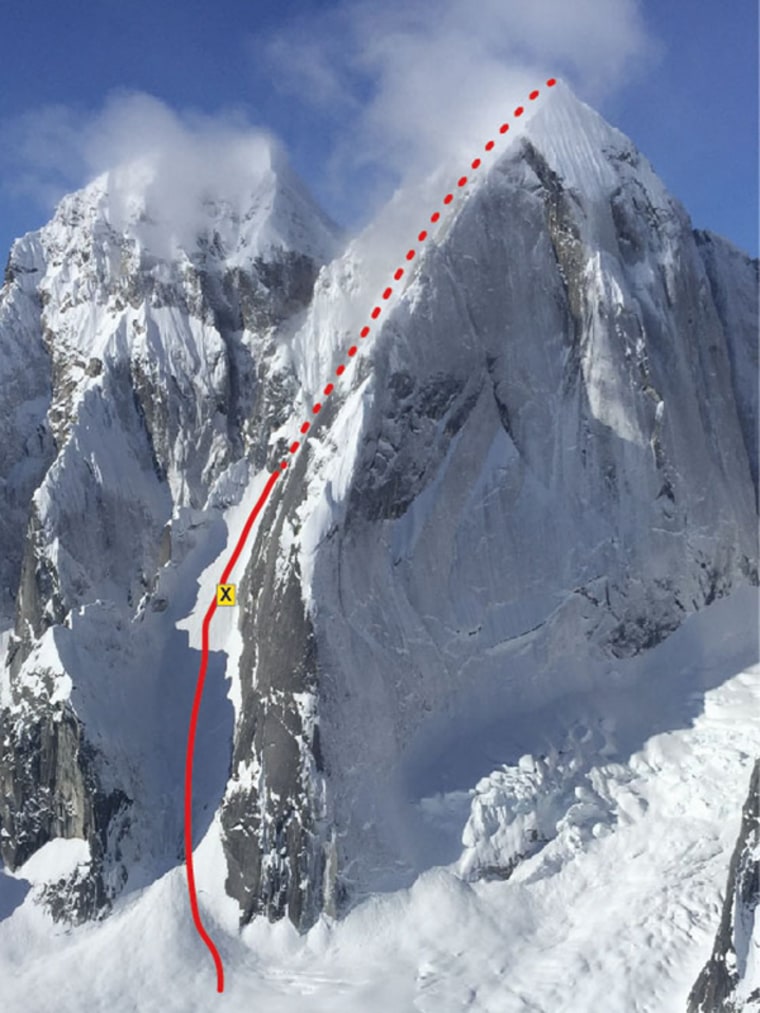
A witness called first responders, fellow climbers built a snow cave to preserve the survivor's temperature and rescuers reached the location Friday morning, the service said.
The pathway the two used is composed of ice, rock and snow, it said.
The perilous route is popular with seasoned climbers who report it can take a good 24 hours to get to the summit and back to base, with some preferring night climbing that may ensure frozen elements instead of wet or slushy ones, according to accounts published by the American Alpine Club.
Mecus was a seasoned climber who has been credited with rescuing others multiple times in upstate New York mountains.
Mecus was interviewed in 2019 as part of the New York City Trans Oral History Project , telling an interviewer she grew up in the city, later got married and had a child, but also "cross-dressed, closeted" before she decided to make her transition, which broke up her marriage.
She said she worked for the state for 17 years as a ranger, which is a sworn law-enforcement position she described as "hyper-macho," before making her transition in the 2010s. Mecus said she fully expected to be out of a job, but was pleasantly surprised, describing the response of colleagues as "overwhelmingly positive."
She drew a lesson from the experience.
"I think visibility is so important," she said. "I’ve come to realize that people with privilege need to fight for people who don’t have that privilege."
Dennis Romero is a breaking news reporter for NBC News Digital.

IMAGES
VIDEO
COMMENTS
We've got insider tips on the best times to visit the most popular parks, timed entry passes, and where to stay. Upon entering California's Yosemite Valley, most visitors pause along the ...
Moncus Park Parking Information. Parking Rates and Details: Rate per Hour: $2.00. Visits Under 30 Minutes: Free. Maximum Rate per Day: $10.00. Lost Ticket per Day: $10.00. Mondays: Free for all visitors. Sales tax is included in all parking rates. Credit cards ONLY at this time.
National Park Getaways. More than 250 National Park Service units have been featured in travel-style articles over the years. New parks are featured each month. Last updated: January 12, 2024. Information to help you plan your visit to the national parks.
El Malpais National Monument. Some of the most famous residents of El Malpais are bats. About 14 species have been observed in the area or call the park their home. Last updated: March 1, 2024. Find a national park by selecting from a list or choosing a state on the map.
ADDRESS. 11321 S Terwilliger Blvd Portland OR 97219. HOURS. Park: 7 am - Sunset. Nature Center: 9am - 4pm (can vary with volunteer support) PHONE NUMBERS. Friends of Tryon Creek (503) 636-4398. Oregon Parks and Recreation (503) 636-9886.
Planning Ahead For Your Visit. Visiting Liberty Island is one of the most rewarding experiences of any trip to New York City. However, visitors who wish to enter the pedestal and visit the crown must secure reservations through Statue City Cruises, the ONLY AUTHORIZED ticket seller for Statue of Liberty National Monument and Ellis Island. The National Park Service has implemented a reservation ...
Welcome! Find your escape in the heart of the city with wide-open fields, skyline views, rolling meadows and shady tree groves. Dix Park is open seven days-a-week from dawn until dusk. Getting to Dix Park. There are multiple entrances into the park. Use this address: 1030 Richardson Drive, Raleigh, NC 27603.
Visit the Park. Prospect Park is a world unto itself: a 585-acre oasis of scenic beauty for relaxation and recreation for our diverse community to enjoy. Browse the menu to inspire and inform your visit. In Things to Do, find information about birdwatching, nature programs, skating and much more. In Places to Go, learn about the LeFrak Center ...
In 2023, the seashores, lakeshores, battlefields, historic sites, monuments and more that make up the National Park Service had 325.5 million visits, an increase of 4 percent from the year before ...
Gorky Park is the most famous park of Moscow, created during the Soviet period as a hub for relaxation and cultural activities. The park is beloved by Muscovites and tourists alike, who visit in all seasons to stroll, enjoy sports, admire the park's attractions, and attend cultural events. Gorky Park is the central part of an ensemble of four ...
5. Gorky Park. Moscow's premier green space, Gorky Park (Park Gor'kogo) is the city's biggest and most famous park. There is entertainment on offer here for every taste, from outdoor dancing sessions to yoga classes, volleyball, ping-pong, rollerblading, and bike and boat rental in summer.
Jefferson Patterson Park and Museum 10515 Mackall Road St. Leonard, Maryland 20685 Phone: 410-586-8538 or Email: [email protected] Park Grounds and Trails. Hours: Park and grounds are open all year from 7:30 am until dusk, except for New Year's Day, Thanksgiving, and Christmas. Free park admission. Visitor C enter
Preparing For Your Trip. Taking time to plan your visit will make your experience more safe, fun, and rewarding. Select a link for the most accurate and up-to-date information about: Safety. Maps. Fees and Passes. Operating Dates, Seasons, and Services. Park Roads. Goods and Services.
Nature & Parks. The Hermitage Garden is a small, beautifully landscaped park in the heart of Moscow. It is popular with office workers and theatre-goers alike, and features a range of attractions including theaters New Opera, Hermitage and Sphera. We've collected the most-often-mentioned 50 places from other articles, including favorites like ...
Phone +1 907-459-3730. Web Visit website. Visiting Alaska's rugged landscapes, in the northernmost national park in America, is a trip of a lifetime. The Gates of the Arctic National Park and Preserve, which includes parts of the Brooks Range, is vast—it's the second largest in the United States—but because there are no roads or ...
The first National Park, Yellowstone, was declared in 1872. Since their introduction, National Parks have become a popular way to spend time with family, friends and yourself, attracting 325.5 million visitors in 2023 alone. What is National Park Week? National Park Week is an annual celebration of our National Parks. It was created by the ...
The best time to visit the park's waterfalls is during spring or after a period of heavy rain (before the hot and dry summers reduce many of them to a trickle). At 93 feet, Overall Run Falls is the tallest in the park reachable via a strenuous 5.1-mile round-trip hike through a designated wilderness area.
On Saturday April 20th, all fees to visit national parks will be lifted to celebrate the first day of National Park Week. Last year, the first day of national park week coincided with Earth Day.
Gorky Central Park of Culture and Leisure is a large park in Moscow, Russia, that features gardens, an open-air movie theater, contemporary art exhibitions and the winter ice rink. The park is famous for its cultural institutions, including the Garage Museum of Contemporary Art and free yoga classes.
Most of the sites managed by the National Park Service are free to visit, but some require an entrance pass. You may also need a vehicle reservation at a few high-traffic sites. Frequent visitors, seniors, military, and others may save money on entrance fees with an America the Beautiful—the National Parks and Federal Recreational Lands Pass, also known an America the Beautiful or ...
Fenway Park, which opened in 1912, is the oldest ballpark in MLB. Wrigley Field, which opened two years later, ranks No. 2. Both rise out of dense sections of their respective cities.
When you visit a Disney park during the Halloween season, you typically will expect to see Halloween decor throughout the park, and perhaps some spooky touches to the daily operations. For example ...
A climber who died after falling 1,000 feet in Alaska's Denali National Park and Preserve was identified on Saturday as Robbi Mecus, a noted climbing enthusiast and forest ranger.. Mecus, 52, from ...